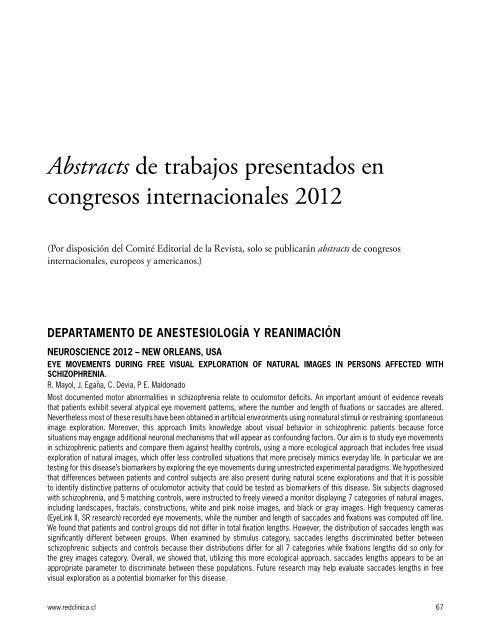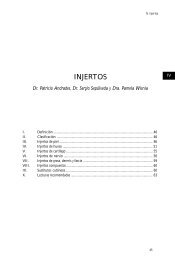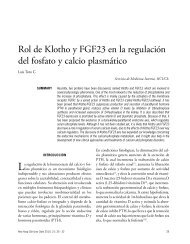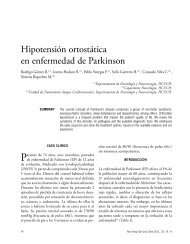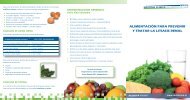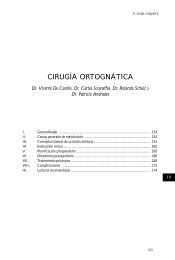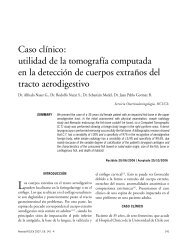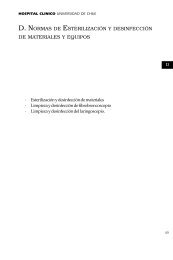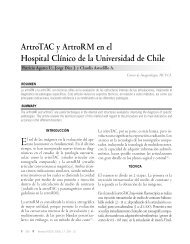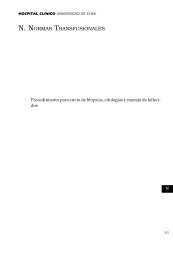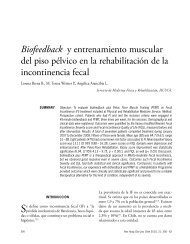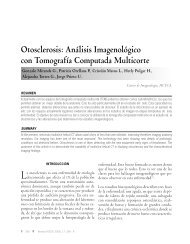Abstracts de trabajos presentados en congresos internacionales 2012
Abstracts de trabajos presentados en congresos internacionales 2012
Abstracts de trabajos presentados en congresos internacionales 2012
Create successful ePaper yourself
Turn your PDF publications into a flip-book with our unique Google optimized e-Paper software.
<strong>Abstracts</strong> <strong>de</strong> <strong>trabajos</strong> <strong>pres<strong>en</strong>tados</strong> <strong>en</strong><strong>congresos</strong> <strong>internacionales</strong> <strong>2012</strong>(Por disposición <strong>de</strong>l Comité Editorial <strong>de</strong> la Revista, solo se publicarán abstracts <strong>de</strong> <strong>congresos</strong><strong>internacionales</strong>, europeos y americanos.)DEPARTAMENTO DE ANESTESIOLOGÍA Y REANIMACIÓNNEUROSCIENCE <strong>2012</strong> – NEW ORLEANS, USAEYE MOVEMENTS DURING FREE VISUAL EXPLORATION OF NATURAL IMAGES IN PERSONS AFFECTED WITHSCHIZOPHRENIA.R. Mayol, J. Egaña, C. Devia, P E. MaldonadoMost docum<strong>en</strong>ted motor abnormalities in schizophr<strong>en</strong>ia relate to oculomotor <strong>de</strong>ficits. An important amount of evi<strong>de</strong>nce revealsthat pati<strong>en</strong>ts exhibit several atypical eye movem<strong>en</strong>t patterns, where the number and l<strong>en</strong>gth of fixations or sacca<strong>de</strong>s are altered.Nevertheless most of these results have be<strong>en</strong> obtained in artificial <strong>en</strong>vironm<strong>en</strong>ts using nonnatural stimuli or restraining spontaneousimage exploration. Moreover, this approach limits knowledge about visual behavior in schizophr<strong>en</strong>ic pati<strong>en</strong>ts because forcesituations may <strong>en</strong>gage additional neuronal mechanisms that will appear as confounding factors. Our aim is to study eye movem<strong>en</strong>tsin schizophr<strong>en</strong>ic pati<strong>en</strong>ts and compare them against healthy controls, using a more ecological approach that inclu<strong>de</strong>s free visualexploration of natural images, which offer less controlled situations that more precisely mimics everyday life. In particular we aretesting for this disease’s biomarkers by exploring the eye movem<strong>en</strong>ts during unrestricted experim<strong>en</strong>tal paradigms. We hypothesizedthat differ<strong>en</strong>ces betwe<strong>en</strong> pati<strong>en</strong>ts and control subjects are also pres<strong>en</strong>t during natural sc<strong>en</strong>e explorations and that it is possibleto i<strong>de</strong>ntify distinctive patterns of oculomotor activity that could be tested as biomarkers of this disease. Six subjects diagnosedwith schizophr<strong>en</strong>ia, and 5 matching controls, were instructed to freely viewed a monitor displaying 7 categories of natural images,including landscapes, fractals, constructions, white and pink noise images, and black or gray images. High frequ<strong>en</strong>cy cameras(EyeLink II, SR research) recor<strong>de</strong>d eye movem<strong>en</strong>ts, while the number and l<strong>en</strong>gth of sacca<strong>de</strong>s and fixations was computed off line.We found that pati<strong>en</strong>ts and control groups did not differ in total fixation l<strong>en</strong>gths. However, the distribution of sacca<strong>de</strong>s l<strong>en</strong>gth wassignificantly differ<strong>en</strong>t betwe<strong>en</strong> groups. Wh<strong>en</strong> examined by stimulus category, sacca<strong>de</strong>s l<strong>en</strong>gths discriminated better betwe<strong>en</strong>schizophr<strong>en</strong>ic subjects and controls because their distributions differ for all 7 categories while fixations l<strong>en</strong>gths did so only forthe grey images category. Overall, we showed that, utilizing this more ecological approach, sacca<strong>de</strong>s l<strong>en</strong>gths appears to be anappropriate parameter to discriminate betwe<strong>en</strong> these populations. Future research may help evaluate sacca<strong>de</strong>s l<strong>en</strong>gths in freevisual exploration as a pot<strong>en</strong>tial biomarker for this disease.www.redclinica.cl 67
DEPARTAMENTO DE MEDICINA3 RD INTERNATIONAL CONGRESS ON ABDOMINAL OBESITY - QUEBEC, CANADÁEVALUATION OF BDNF EXPRESSION IN LIVER, VISCERAL AND SUBCUTANEOUS FAT FROM OBESE SUBJECTS, BYIMMUNOHISTOCHEMESTRY.AV. Araya, V. Tapia, E. Lanzarini, X. Orellana, M. Maripangui, C. Pauls<strong>en</strong>, C. Romero, ME. VillanuevaBDNF neurotrophin can act on nonneuronal cells. There are evi<strong>de</strong>nces of its role in metabolic actions. Objective: To evaluate byimmunohistochemistry technique, the expression of BDNF in liver, subcutaneous (SF) and visceral fat (VF) of non-diabetic obeseand control subjects. Pati<strong>en</strong>ts and methods: 15 subjects with BMI≥30 kg/m 2 and < 26 kg/m 2 who un<strong>de</strong>rw<strong>en</strong>t abdominal surgerywere selected. A fasting blood sample was tak<strong>en</strong> for measurem<strong>en</strong>t of glucose, insulin and lipid profile. A liver, subcutaneous andom<strong>en</strong>tal fat biopsy was obtained for immunohistochemistry evaluation of BDNF protein expression levels. To quantify its expressionin histological sections, we used the software Image-Pro Plus 6.2. A p value < 0.05 was consi<strong>de</strong>red statistically significant. Results:T<strong>en</strong> obese subjects (8F/2M), age: 37.7±13.6 years, BMI: 33±2.7 kg/m 2 and 5 female control subjects, age 44.4±3.8 years, BMI:22.9±2.2 kg/m 2 , were evaluated. BMI, waist circumfer<strong>en</strong>ce, fasting insulin, HOMA and LDL cholesterol were significantly higher inthe obese group (p=0,005). The expression of BDNF in VF was higher than in SF in both groups (p< 0.005). In obese subjects, BDNFexpression in liver tissue was higher than in controls (p=0.0094). There were no differ<strong>en</strong>ces betwe<strong>en</strong> groups in the expression ofBDNF in SF or VF. Liver steatosis was found in obese subjects. Conclusions: The increased expression of BDNF protein in visceralfat could be associated with local metabolic process. In obese subjects, the increased BDNF liver expression probably is relatedwith insulin resistance and fatty liver disease.18° INTERNATIONAL LIVER TRANSPLANTATION SOCIETY - SAN FRANCISCO, USASURVIVAL IN PATIENTS UNDERGOING ORTHOTOPIC LIVER TRANSPLANTATION AT THE HOSPITAL CLINIC, UNIVERSITYOF CHILE.Juan Pablo Miranda, Danny Oks<strong>en</strong>berg, Jaime Poniachik, Jorge Cor<strong>de</strong>ro, José Ibarra, Esteban Villagra, Angélica Bórquez, JaimeCastillo, Gonzalo Car<strong>de</strong>mil, Juan Carlos Díaz.Introduction: Orthotopic liver transplantation (OLT) has become an effective procedure for pati<strong>en</strong>ts with advanced liver disease,reporting a survival rate betwe<strong>en</strong> 70% - 80% at 36 months. In our country there are few publications in relation to graft survivalin OLT. Aim: To evaluate the survival post OLT at the Hospital Clinic, University of Chile. Material and Methods: A retrospectivestudy of <strong>de</strong>mographic and clinical variables of pati<strong>en</strong>ts un<strong>de</strong>rgoing OLT at the Hospital Clinico Universidad <strong>de</strong> Chile, by creating astandardized database and subsequ<strong>en</strong>t application of survival analysis and a mo<strong>de</strong>l Cox proportional hazards Results: We evaluated134 OLT performed during the period 2002-2011, there was a 55.8% male pati<strong>en</strong>ts, mean age was 53.8±10.6 (21-68) years,median graft survival time of 38.9 months. The use of cyclosporine compared to tacrolimus as primary immunosuppressant wasassociated with an increased preval<strong>en</strong>ce of infections (23.0% v/s 8%) and mo<strong>de</strong>rate and severe graft rejections (17% v/s 9%), p
was hematocrit and hemoglobindiffer<strong>en</strong>ce betwe<strong>en</strong> the time of registration on the waiting list and pre-OLTof 2 % points and 0.8 g/dl,HR 2.7 (1.2 - 3.1) and 2.7 (1.4 - 3.5) respectively. The infections (23.0% v/s 8%) and mo<strong>de</strong>rate and severe graft rejections (17% v/s9%) were more frequ<strong>en</strong>t at CsA-me group (p
female. Intestinal motility was assessed by perfused catheters and external transducers with standardized technique during 309± 47 minutes and 279 ± 49 minutes in pati<strong>en</strong>ts and healthy subjects, respectively. The cyclic activity (CA), duration of MMC,duration of MMC’s phases, amplitu<strong>de</strong> and frequ<strong>en</strong>cy of contractions in phase II and III, intestinal motility score (IMS) and clusteredcontractions were evaluated. The referral for consultation was chronic diarrhea in 10 pati<strong>en</strong>ts, constipation in 4, abdominal pain in3, gastroesophageal reflux in 3, intestinal pseudoobstruction in 3 and 2 pati<strong>en</strong>ts with gastric ret<strong>en</strong>tion syndrome. History of totalor partial gastrectomy plus vagotomy was found in 12 pati<strong>en</strong>ts. Statistical analysis was assessed using t-test and Kruskal-Wallis.Results: From the pati<strong>en</strong>ts group, 9 did not showed a phase III during the <strong>en</strong>tire study, whereas all from the control group hadcyclical activity. The pres<strong>en</strong>ce of clustered contractions was pathological (> 4 per hour) in 4 pati<strong>en</strong>ts and none in the control group(0.036). There were no differ<strong>en</strong>ces betwe<strong>en</strong> gastrectomized and non gastromized pati<strong>en</strong>ts. Conclusion: Vagotomized pati<strong>en</strong>tswith digestive symptoms show severe small intestinal motor disor<strong>de</strong>rs. The most frequ<strong>en</strong>t symptom after vagotomy was chronicdiarrhea. The pres<strong>en</strong>ce of gastrectomy did not increase the severity of the intestinal motor disor<strong>de</strong>r. The abs<strong>en</strong>ce of cyclical activityfound in almost one third of the pati<strong>en</strong>ts and the differ<strong>en</strong>ces in intestinal motility, suggest a neuropathic pattern. However, studieswith a greater number of pati<strong>en</strong>ts are nee<strong>de</strong>d.XXXI WORLD CONGRESS OF INTERNAL MEDICINE – SANTIAGO, CHILECARCINOID NEUROENDOCRINE TUMOR TREATMENT WITH RADIONUCLIDES. CASE REPORT.R. Collado, J. Carmona, P. Zhindon, P. González.Introduction: Neuro<strong>en</strong>docrine tumors (NETs) gastro<strong>en</strong>teropancreatic repres<strong>en</strong>t about 2% of all gastrointestinal tumors. It hasan inci<strong>de</strong>nce of 2.5-5 cases per 100,000 per year. The term carcinoid refers to tumors that originate in ileal <strong>en</strong>terochromaffincells produce serotonin which have better prognosis than a<strong>de</strong>nocarcinomas. Description: Male pati<strong>en</strong>t, 55 years old. History ofhypert<strong>en</strong>sion treatm<strong>en</strong>t. Mother dies of intestinal NET. During routine monitoring is performed r<strong>en</strong>al Doppler ultrasound scanwhere hepatic nodule scre<strong>en</strong>ing solid hypervascularized right. MRI is requested and displayed multiple hypervascular liver lesions,suggestive of secondary lesions. During gastro<strong>en</strong>terology Control refers colicky abdominal pain, diarrhea without pathologicalelem<strong>en</strong>ts and episo<strong>de</strong>s of flushing objectified during the interview. Discussion: It is proposed as a likely diagnosis NET carcinoidwith liver metastases and carcinoid syndrome. Requested PET/CT 68Ga which conclu<strong>de</strong>s as primary carcinoid tumor of small bowelloop, possibly ileum, mes<strong>en</strong>teric and hepatic secondary locations. A year later he performed echocardiography in highlightingmild pulmonary hypert<strong>en</strong>sion, tricuspid reflux mild and mo<strong>de</strong>rate pulmonary reflux with good LV systolic function. Again requestedPET/CT 68Ga which highlights frank progression from prior examination also adding another commitm<strong>en</strong>t to small bowel loop inthe right iliac fossa. The pati<strong>en</strong>t repeatedly refuses to un<strong>de</strong>rgo surgery or biopsy and Nuclear Medicine is <strong>de</strong>rived which <strong>de</strong>ci<strong>de</strong>ssequ<strong>en</strong>tial therapy with radionucli<strong>de</strong>s. After 3 sessions, we conclu<strong>de</strong> from the systemic tracking of each meeting, that: no evi<strong>de</strong>nceof disease progression with a partial response and <strong>de</strong>creased tumor tissue somatostatin receptor positive, and no evi<strong>de</strong>nce ofspread to other locations (not there is uptake in the chest or heart area which is ruled by metastases in this area and <strong>en</strong>docardialdamage would be giv<strong>en</strong> by mediators). During last session is requested echocardiography (7 months after the first) that displaysand nonspecific diffuse involvem<strong>en</strong>t of predominantly right valve with mo<strong>de</strong>rate pulmonary regurgitation, mild tricuspid st<strong>en</strong>osisand severe insuffici<strong>en</strong>cy, severe dilated right atrium and inferior v<strong>en</strong>a cava, septal hypertrophy mild, mild dilation of aortic root andright atrium with preserved LV systolic function, which does not correlate with the relative good functionality of the pati<strong>en</strong>t. Thiscase illustrates that in NET radionucli<strong>de</strong> therapy is effective in <strong>de</strong>creasing the progression of disease, and also <strong>de</strong>monstrates therapid and severe <strong>en</strong>docardial commitm<strong>en</strong>t typical of advanced stages of this disor<strong>de</strong>r.LEFT MAIN CORONARY TRUNK ORIGINATED IN PULMONARY ARTERY IN AN ADULT. CASE REPORT.H. Ugal<strong>de</strong>, M Muñoz, D. Ugal<strong>de</strong>, S. García, E. FariasIntroduction: Coronary arteries origin anomalies are <strong>de</strong>tected in 0.5 – 1.5% of all angiographies; in Chile the most frequ<strong>en</strong>t isanomalous origin of right coronary artery from left coronary sinus. Anomalous origin of the left main trunk is the most rareand its origin from pulmonary artery in adults is exceptional, usually because it’s not compatible with reaching adult age.This is the first reported case of this anomaly in an adult pati<strong>en</strong>t in our country. Description: An 49 years old female, chronicsmoker, dislipi<strong>de</strong>mic, that pres<strong>en</strong>ted with 2 months history of typical non progressive angina. The physical exam was normalas electrocardiography and echocardiography, exercise electrocardiogram suggested ischemia. Reinterrogation revealedmo<strong>de</strong>rated efforts dyspnea from young age without any study. Coronary angiography was performed, it showed abs<strong>en</strong>ce ofthe left main trunk in the left coronary sinus, dilated right coronary artery, with no lesions and ext<strong>en</strong>sive collateral circulation toanterior <strong>de</strong>sc<strong>en</strong>ding and circumflex arteries, with inverted flow left main trunk draining to the pulmonary artery. Left v<strong>en</strong>triclewas mildly dilated with middle and apical anterior hypokinesia, global systolic function was conserved. Surgical correction was70Revista Hospital Clínico Universidad <strong>de</strong> Chile
<strong>de</strong>ci<strong>de</strong>d occluding left main anomalous origin and performing coronary artery bypass grafting from left internal thoracic artery.The pati<strong>en</strong>t is discharged with no complications, at 2 years follow-up she is symptom free and has a normal physical capacity.Discussion: The <strong>de</strong>scribed anomaly is an exceptional finding and its pres<strong>en</strong>tation in adulthood is ev<strong>en</strong> more rare, this particularcase illustrates a appar<strong>en</strong>tly late clinical manifestation but the pati<strong>en</strong>t referred mild symptoms from childhood. The diagnosis ofthis coronary anomaly can be ma<strong>de</strong> with less invasive means such as CT angiography but confirmation requires coronary arteryangiography and treatm<strong>en</strong>t is always surgical, with good outcome.MEDIASTINIC FIBROSIS AS AN ATYPHIC PRESENTATION OF SILICOSIS.L. Toro, D. Sanhueza, M. RuizIntroduction: Silicosis is a respiratory disease, secondary to chronic silica inhalation. It is most frequ<strong>en</strong>tly se<strong>en</strong> in miners, glassand ceramic workers. It is g<strong>en</strong>erally pres<strong>en</strong>ted as respiratory symptoms of progressive installation. Although, there are atypicalpres<strong>en</strong>tations such as mediastinic fibrosis, that mimics other etiologies such as lung cancer and tuberculosis, as exposed in thiscase. Description: A 57-year old male, bus driver, who worked as miner for 27 years. He had a history of hypert<strong>en</strong>sion, gout andchronic tobacco smoking (13 pack years), previously asymptomatic. He <strong>de</strong>veloped acute retrosternal thoracic pain, associatedto palpitations and sweats. He was evaluated in the Emerg<strong>en</strong>cy Room, an EKG was <strong>de</strong>veloped which did not show ischemia orother alterations. Cardiac <strong>en</strong>zymes were in normal ranges with no evolutionary changes. Chest X-ray was within normal ranges.Thorax CT was negative for pulmonary embolism and acute aortic syndrome; it showed mediastinic lymph no<strong>de</strong>s, a pulmonarynodule of 1.5 cm in left lower bronchial bifurcation and several pulmonary nodules up to 6 mm without calcifications. Bonescintigraphy, head CT, abdominal and pelvis CT were within normal ranges. Fibrobronchoscopy showed an extrinsic bronchialcompression at the bifurcation of upper and lower left bronchi. PPD and ELISPOT TB test were negatives. A vi<strong>de</strong>othoracoscopybiopsy was performed that showed lymph no<strong>de</strong>s and lung tissue with <strong>de</strong>nse sclerosis foci associated to fine crystal <strong>de</strong>posits,with no evi<strong>de</strong>nce of granulomas or neoplastic cells, compatible with lung and ganglionar silicosis. Ziehl-Neels<strong>en</strong> stain and Kochculture negatives. Thorax MRI showed subcarinal mediastinic and left hiliar mass, plus mediastinic fibrosis. Final diagnosis:Mediastinic fibrosis secondary to Silicosis. Therapy with Prednisone was initiated, evolving with reduction of pain and respiratorysymptoms. He was discharged in good conditions, with ambulatory follow up with Pulmonology Physician. 1 year after thishospitalization, the pati<strong>en</strong>t had evolved in good conditions, asymptomatic, ELISPOT TB persist<strong>en</strong>tly negative, with a significantreduction of lung images in Thorax CT. Discussion: Silicosis is a disease which has many pres<strong>en</strong>tations, as se<strong>en</strong> in this casereport. Because its treatm<strong>en</strong>t <strong>de</strong>mands to remove silica exposure and use of systemic glucocorticoids, an early diagnosis ismandatory. This <strong>en</strong>tity should be consi<strong>de</strong>red in differ<strong>en</strong>tial diagnosis of cardiorespiratory symptoms, especially in pati<strong>en</strong>ts withrisk factors for Silicosis, where main causes have be<strong>en</strong> exclu<strong>de</strong>d.CONGESTIVE HEPATOPATHY AS PRESENTATION OF CONSTRICTIVE PERICARDITIS. CASE REPORT.D. Ugal<strong>de</strong>, M. Muñoz, M. Cereceda, H. Ugal<strong>de</strong>Introduction and Description: Constrictive pericarditis is an infrequ<strong>en</strong>t disease, it has classical hemodynamic characteristics andphysical exam findings. In some cases congestive hepatopathy can be its initial manifestation. We report the case of a previouslyhealthy 27 year old male that pres<strong>en</strong>ted with 6 weeks history of weight loss, dyspnea, peripheral e<strong>de</strong>ma and increased abdominalvolume. Cirrhosis was suspected. He was admitted to our hospital for study. The pati<strong>en</strong>t had clinical ascites, and jugular v<strong>en</strong>ousdist<strong>en</strong>sion. He had mildly elevated alkaline phosphatase and gamma glutamyl transferase. Cardiac cause for hepatic compromisewas suspected on clinical basis. Diuretics were started and hepatic MRI done, suggesting secondary congestion, echocardiography<strong>de</strong>tected diastolic dysfunction and mo<strong>de</strong>rate to severe pulmonary hypert<strong>en</strong>sion. Thorax CT showed no signs of pulmonary embolismand auto-antibodies were negative. Cardiac MRI showed pericardial thick<strong>en</strong>ing. Cardiac catheterization was done and reveale<strong>de</strong>qualization of pressure betwe<strong>en</strong> right and left chambers, and right v<strong>en</strong>tricle curve showed abrupt <strong>de</strong>crem<strong>en</strong>t and subsequ<strong>en</strong>tplateau, the “square root” sign, confirming constrictive pericarditis. Pericardiectomy was performed and pati<strong>en</strong>t evolved with totalrecovery, remaining asymptomatic in follow up. Pathology was not specific and tissue cultures were negative. Discussion: This caseun<strong>de</strong>rscore the need to consi<strong>de</strong>r cardiac diseases as a possible cause for hepatic compromise, that is caused by the elevatedhepatic sinusoid pressure, accumulation of <strong>de</strong>oxyg<strong>en</strong>ated blood therefore producing atrophy, fibrosis and necrosis. Clinically theheart failure predominates and prognosis of congestive hepatopathy <strong>de</strong>p<strong>en</strong>ds on the heart disease. Constrictive pericarditis iscaused by pericardial thick<strong>en</strong>ing and fibrosis, as a consequ<strong>en</strong>ce of inflammation of any cause. Chambers become confined andpressure equalization occur, precocious diastolic filling is early and causes the square root sign, cardiac output is reduced andv<strong>en</strong>ous pressure increases, impacting liver as <strong>de</strong>scribed. Physical exam may pres<strong>en</strong>t as findings pericardial knock, jugular v<strong>en</strong>ousdist<strong>en</strong>tion and kussmaul sign. Electrocardiography is not specific; echocardiography can suggest the disease. Cardiac MRI canwww.redclinica.cl 71
visualize pericardial thick<strong>en</strong>ing in <strong>de</strong>tail and to confirm the diagnosis cardiac chamber pressures measurem<strong>en</strong>t are used as inthis case. Surgical managem<strong>en</strong>t with pericardiectomy resolves chamber confinem<strong>en</strong>t restoring normal function. It is relevant toconsi<strong>de</strong>r a broa<strong>de</strong>r diagnosis and a <strong>de</strong>tailed history and physical exam remains as key elem<strong>en</strong>ts, with a<strong>de</strong>quate use of imaging andinvasive procedures to gain diagnostic precision.TREPONEMA PALLIDUM AND HEPATITIS B CO – INFECTIONS IN HIV PATIENTS RECENTLY DIAGNOSED.L. Pizarro Chamorro, C. Gallardo Araneda, E. Cortés SedanoObjectives: Treponema Pallidum and Hepatitis B share transmiss ion routes and can facilitate infection by HIV. This study aimsto <strong>de</strong>termine the preval<strong>en</strong>ce of curr<strong>en</strong>t or past infection with Treponema Pallidum or Hepatitis B in HIV pati<strong>en</strong>ts diagnosed at aUniversity Hospital. Material and methods: Medical records of HIV pati<strong>en</strong>ts diagnosed and controlled in the Hospital Clínico <strong>de</strong> laUniversidad <strong>de</strong> Chile betwe<strong>en</strong> 1997 and 2011 were reviewed. The record inclu<strong>de</strong>d: Hepatitis B surface antig<strong>en</strong> (HBsAg), IgM and IgGanti-HBc antibodies, and VDRL or RPR test performed at diagnosis. History of treated syphilis before diagnosis was also recor<strong>de</strong>d.Results: Two hundred eighty pati<strong>en</strong>ts aged 18 to 70 years were inclu<strong>de</strong>d (261 males). At diagnosis, there were no pati<strong>en</strong>ts withHBsAg positive, 56% of m<strong>en</strong> and no wom<strong>en</strong> had anti- HBc antibodies positive, and 17% of m<strong>en</strong> and no wom<strong>en</strong> had VDRL / RPRreag<strong>en</strong>ts tests or history of treated syphilis. Conclusions: In this study, m<strong>en</strong> with HIV infection diagnosis have a high preval<strong>en</strong>ceof past infection (but not curr<strong>en</strong>t) by Hepatitis B, and to a lesser ext<strong>en</strong>t, by past or curr<strong>en</strong>t infection by Treponema Pallidum. Thatreality is not observed in the group of wom<strong>en</strong>.20 YEARS OF CORONARY ANGIOGRAPHY. PATIENT CHARACTERIZATION, OUTCOMES AND COMPLICATIONS IN ACHILEAN UNIVERSITARY CENTER.H. Ugal<strong>de</strong>, A. Ramírez, D. Ugal<strong>de</strong>, M. Muñoz, F. Ayala, S. García, G. Dusaillant, E. Chaigneau, E. Farias.Coronary angiography is an invasive procedure used to evaluate coronary arteries anatomy and st<strong>en</strong>osis lesions. The procedure hasclear indications and known complications Purpose: Describe the last 20 years of experi<strong>en</strong>ce of cine-coronary angiography in our<strong>de</strong>partm<strong>en</strong>t, emphasizing its outcomes and complications. Material and Methods: Prospective record of every diagnostic coronaryangiography in our c<strong>en</strong>ter from January 1992 to December 2011, obtaining <strong>de</strong>mographic data, outcomes and complications.Results: 13717 pati<strong>en</strong>ts were studied; mean age 60.2 years (range 14-100), male 68.9%, risk factors: hypert<strong>en</strong>sion (53%), smoking(26%), dyslipi<strong>de</strong>mia (24%) and diabetes (20%). Clinical diagnosis to indicate coronary angiography was myocardial infarctionin 26%, chronic and stable angina in 22%, unstable angina 19%, and valvular heart disease 8%. A 16% of pati<strong>en</strong>ts had relevantcomorbidities, more frecu<strong>en</strong>t were peripheral arterial disease and chronic kidney failure. The femoral approach was used in 88%of procedures and radial access in 8.5%. The first attempt was unsuccessful in 0.1%, but all were succesful in a second attempt.Five operators performed 94% of procedures. The Coronary arteries anatomy was normal in 94.9% of cases; the most frequ<strong>en</strong>tanomalies were muscular bridge (1.53%) and anomalous origin of coronary arteries (1.47%). 30% of pati<strong>en</strong>ts had no significativelesions, 22% had single vessel disease, 15% two o three vessel with critical st<strong>en</strong>osis; 3% trunk lesion. 90% were right-dominant.During the procedure 3.4% pati<strong>en</strong>ts pres<strong>en</strong>ted some complications: 0.1% were severe, 0.04% stroke, acute coronary occlusion and0.03% anaphylactic shock. After procedure 2,3 % have some complications, 0.1% severe: 0.07% r<strong>en</strong>al injury requiring dialysis and0.03% cholesterol emboli. 0.5% of pati<strong>en</strong>ts pres<strong>en</strong>ted local complications: pseudoaneurism in 0.3%, large hematomas in 0.15% andacute arterial thrombotic occlusion in 0.07%, 0.2% required local surgery. A total of 19 pati<strong>en</strong>ts died (0.14%), 14 of them had acutemyocardial infarction with cardiog<strong>en</strong>ic shock before interv<strong>en</strong>tion; 5 pati<strong>en</strong>ts (0.04%) died directly from the procedure. Conclusions:Coronary angiography is an invasive procedure, used mainly in the study for rule out coronary artery disease. As a procedure wasmore frequ<strong>en</strong>tly in m<strong>en</strong>, with low comorbidity, and with 30% of cases with no relevant st<strong>en</strong>osis. The complication rate was low andits mortality was related to very critical disease.OXIDATIVE STRESS IN PATIENTS UNDERGOING CARDIAC SURGERY AND ITS RELATIONSHIP WITH POSTOPERATIVEATRIAL FIBRILLATION.Gutiérrez R, Fernán<strong>de</strong>z R, Briones JL, Miranda A, Rodrigo R.Purpose: Atrial fibrillation is the most common complication of cardiac surgical procedures performed with cardiopulmonarybypass. It contributes to increased hospital l<strong>en</strong>gth of stay and treatm<strong>en</strong>t costs. The pathog<strong>en</strong>esis of postoperative atrial fibrillationis consi<strong>de</strong>red to be multifactorial. However oxidative stress is a major contributory factor as the consequ<strong>en</strong>ce of ischemia/reperfusion ev<strong>en</strong>t occurring in this setting. Consi<strong>de</strong>rable evi<strong>de</strong>nce suggests the involvem<strong>en</strong>t of reactive oxyg<strong>en</strong> species (ROS) inthe pathog<strong>en</strong>ic mechanism of this arrhythmia. The aim of this study was to <strong>de</strong>termine the profile of blood oxidative stress andantioxidant <strong>de</strong>f<strong>en</strong>se biomarkers in pati<strong>en</strong>ts un<strong>de</strong>rgoing cardiac surgery with extracorporeal circulation, and their association with72Revista Hospital Clínico Universidad <strong>de</strong> Chile
the occurr<strong>en</strong>ce of postoperative atrial fibrillation (AF). Material and methods: This is a <strong>de</strong>scriptive study conducted in the Universityof Chile Clinical Hospital, betwe<strong>en</strong> 2007 and 2010 on 82 pati<strong>en</strong>ts un<strong>de</strong>rgoing cardiac surgery with extracorporeal circulation.Blood was sampled throughout the protocol and atrial tissue was obtained during surgery. Antioxidant status was <strong>de</strong>terminedthrough the ferric reducing ability of plasma (FRAP), erythrocyte and atrial tissue thiol in<strong>de</strong>x (reduced/oxidized glutathione ratio)and antioxidant <strong>en</strong>zymes activity. Oxidative stress was assessed through malondial<strong>de</strong>hy<strong>de</strong> (MDA) and protein carbonylationmeasurem<strong>en</strong>ts. The leukocyte count, levels of fibrinog<strong>en</strong> and high-s<strong>en</strong>sitivity C-reactive protein (hs-CRP) were also <strong>de</strong>termined asinflammation-related parameters. P< 0.05 was consi<strong>de</strong>red statistically significant. Results: Postoperative AF occurred in 26 of 82pati<strong>en</strong>ts (31.7%). Pati<strong>en</strong>ts with postoperative AF had higher levels of malondial<strong>de</strong>hy<strong>de</strong> and protein carbonylation, but lower levels ofFRAP and glutathione peroxidase activity. The highest level of hs-CRP was reached following 8 h in the postoperative period. Themultivariate regression analysis significantly showed positive association betwe<strong>en</strong> the levels of hs-CRP and MDA and the occurr<strong>en</strong>cepostoperative AF. The area un<strong>de</strong>r the ROC curves for hs-CRP and MDA were 0.73 and 0.69, respectively. Conclusions: Our resultsare in agreem<strong>en</strong>t with previous studies, in confirming that pati<strong>en</strong>ts with postoperative AF pres<strong>en</strong>t a higher oxidative damage. Dataare consist<strong>en</strong>t with the view that this damage is an unavoidable ev<strong>en</strong>t in cardiac surgery with extracorporeal circulation. Further,plasma hs-CRP and MDA levels, at the early postoperative period, are valuable predictors of the occurr<strong>en</strong>ce of AF in the setting ofcardiac surgery with extracorporeal circulation.MAGNETIC RESONANCE IMAGING IN THR DIAGNOSIS OF MYOCARDITIS. CLINICAL CHARACTERISTICS ANDLABORATORY TEST OF PATIENTS WITH DIANGNOSIS OF MYOCARDITIS.Llancaqueo M, Ramos C, Díaz JC, Lara J, Valdivieso M, Barría A, Aramburu I.Introduction: acute Myocarditis (Mc) is not a wi<strong>de</strong>ly recognized <strong>en</strong>tity in the clinical practice <strong>en</strong>tity giv<strong>en</strong> its variable clinicalpres<strong>en</strong>tation and lack of a “gold standard” method of diagnosis. Magnetic Resonance Imaging (MRI) in our country is a rec<strong>en</strong>tlyintroduced method of study of cardiac conditions.Objectives: To <strong>de</strong>scribe the variables in <strong>de</strong>mographics, clinical, ECG, biomarkersand pati<strong>en</strong>t images in pati<strong>en</strong>ts who have be<strong>en</strong> hospitalised for probable myocarditis and who are MRI compatible. As well to<strong>de</strong>scribe the findings of the MRI. Method: We ma<strong>de</strong> an evaluation of all the pati<strong>en</strong>ts admitted to the Cardiology service of ourhospital who were suspected of having myocarditis betwe<strong>en</strong> 2006 and August 2011. The MRI was run on a Siem<strong>en</strong>s SONATA unitof 1.5 tesla. Syngo and ARGUS Softwares. Protocol: Series of cineMR, (powered by T2 (tripleIR), FLASH IR sequ<strong>en</strong>ce to evaluatethe significance 10 minutes after the use of gadolinium. Short axis, longitudinal and transversal long axis. Image interpretation:semiautomatic motility analysis with ARGUS software, visual analysis of the embossing and e<strong>de</strong>ma. Results: We diagnosedMyocarditis in 22. 20 males (M), Age 28,8 years old ± 13 (15 a 61 range). Clinical chacaracteristics: Tobacco 10 (45%), drugs2 (6,%), (1 cocaine y 1 marijuana), Lupus 2, previous respiratory infections 11(50%) y digestive manifestation 1 (5%). Clinicalsymptoms: thoracic pain 20(91%), fever 12 (55%), dyspnea 5 (23%). Admission ECG :SDST 13 (59%), IDST 1 (5%), T wave alterations8 (36%), PQ 2 irregularity (9%), Q wave 4(18%), v<strong>en</strong>tricular arrhythmia 2 (13%), FA 1(5%). Biomarker elevations: CK total 19 (86%)and 560 ± 396 UI, CK MB 20 (91%) and 68±57 UI, Troponin 20 (91%), 14 ±10 ng/ml. Echocardiogram: FE below 55% in 4 ( 18%),mo<strong>de</strong>rated aortic insuffici<strong>en</strong>cy 1 (5%), severe IT 1 (5%), slight to mo<strong>de</strong>rated HTP in 2 (9%), diastolic dilation VI (> 57 mm) in 2 (9%),sistolic dilation of VI (> 37 mm) in 6 (27%), alteration of the motility segm<strong>en</strong>ts 12 (55%), pericardial bleeding 6 (27%). Coronographywas performed on 10 pati<strong>en</strong>ts (45%), all cases were normal. MRI was performed in all cases, diagnosis of Myocardiatis wasconfirmed. Diagnostic: “gadolinium <strong>en</strong>hancem<strong>en</strong>t (LGE) at least in 1 segm<strong>en</strong>t, of 17 possible, in a non ischemic pattern on patch, in100% of cases. MRI findings: Out of 374 of evaluated segm<strong>en</strong>ts we found: E<strong>de</strong>ma, motility alteration y belated embossing on 15%,16% y 26% respectively. The most frequ<strong>en</strong>t segm<strong>en</strong>ts affected by E<strong>de</strong>ma were 5, 11, 12 and 16. Motility alteration 5, 12, 15 and16, y belated significance on segm<strong>en</strong>ts 5,11 and 16. Conclusion: MRI is a useful tool in the diagnosis of Myocarditis. In our seriesof results we discovered that the damage to the left v<strong>en</strong>tricle was of a non uniform nature in which the most frequ<strong>en</strong>tly affectedsegm<strong>en</strong>ts are the inferolateral wall.CLINICAL FOLLOW-UP IN PATIENTS ABLE TO REACH 10 METS IN THEIR TREADMILL EXERCISE STRESS TESTASSOCIATED TO 99MTC-SESTAMIBI SPECT FINDINGS.JS. González, H. Prat, I. Berrocal, F. Kuschel, I. Ruiz, T. MassardoBeing able to achieve 10 METS during an exercise test appears to have a good negative predictive value for cardiac ev<strong>en</strong>ts incoronary artery disease (CAD), in<strong>de</strong>p<strong>en</strong><strong>de</strong>nt of their cardiac conditions. AIM: to know the outcome in pati<strong>en</strong>ts with ≥10 METS intheir treadmill exercise test associated with myocardial ischemia. METHODS: We reviewed 2.571 consecutive stress myocardialSPECT since 2006, 780 of them performed exercise stress test (EST); 152 were able to reach ≥10 METS and ≥85% maximalpredicted heart rate (MPHR); 82% males; group age was 56±9 years (range: 26-77 y; 5%
factors. All performed Bruce protocol and were studied with gated 99mTc-sestamibi SPECT. Record of major or minor cardiacev<strong>en</strong>ts was performed via phone contact or reviewing clinical files. RESULTS: SPECT was required due to CAD scre<strong>en</strong>ing in 75%(including pre-operatories) and to CAD risk stratification in 25% (including myocardial infarction and/or revascularization); 99% in INYHA functional class. Rest electrocardiogram was normal in 41%; had Q wave in 6% and other conduction abnormalities in 12%(no left bundle branch block). Main EST parameters were: test duration 9±1 min; MPHR 94±6%; METS 11.5±1.7; 48% susp<strong>en</strong><strong>de</strong>dfor fatigue; 47% reached MPHR and the rest for dyspnea, hypert<strong>en</strong>sive response or angina. EST was positive for ischemia in16%, negative in 64% and non-conclusive in 20%. SPECT myocardial perfusion was normal in 72%; all but one had a<strong>de</strong>quate leftv<strong>en</strong>tricular function without dilation. There were reversible perfusion <strong>de</strong>fects in 25% of cases (10% with some fixed compon<strong>en</strong>t) andonly 4% with fixed <strong>de</strong>fects. Ischemia was mo<strong>de</strong>rate or severe in 47% of reversible cases. There was 75% of concordance betwe<strong>en</strong>reported ischemia with EST and reversibility with SPECT (Coh<strong>en</strong> kappa: 0.31). We were able to follow-up 79% cases [mean: 25±16m; median: 24 m; range: 3-81 m]. There were no cardiac <strong>de</strong>aths, myocardial infarctions. We rule-out <strong>de</strong>ath in the rest inquiring in ourcivil registration office. There were 6 coronary revascularization procedures performed within 1 year post SPECT, in pati<strong>en</strong>ts withsignificant reversible ischemia. CONCLUSION: A quarter of our pati<strong>en</strong>ts submitted to myocardial SPECT with good exercise capacityhad reversible perfusion <strong>de</strong>fects. There were no major cardiac ev<strong>en</strong>ts; 16% of the pati<strong>en</strong>ts with SPECT ischemia were submitted torevascularization. In good functional capacity pati<strong>en</strong>ts, this findings support the i<strong>de</strong>a to select with appropriate criteria non-invasivestrategies to evaluate CAD, in spite of their relative good prognosis.BIOCHEMICAL AND METABOLIC CHARACTERISTICS IN COCAINE DEPENDENT INDIVIDUALS STUDIED DURINGRECENT ABSTINENCE.T. Massardo, V. Araya, I. Ruiz, F. Kuschel, J. Pallavicini, J. Véliz, R. Jaimovich, S. Rodríguez, O. Panes, J. PereiraCocaine use is a well known risk factor (RF) for vascular complications such as myocardial infarction and stroke, whichcharacteristically affect young individuals. Besi<strong>de</strong>s the direct <strong>de</strong>leterious effect of cocaine on the vessel wall, other RF couldcontribute to the <strong>de</strong>velopm<strong>en</strong>t of premature atherothrombotic ev<strong>en</strong>ts. AIM: to characterize a population of cocaine addicts from abiochemical and metabolic standpoint compared with healthy controls. Methods. We studied 63 DSM IV cocaine <strong>de</strong>p<strong>en</strong><strong>de</strong>nts duringrec<strong>en</strong>t abstin<strong>en</strong>ce (with consumption prov<strong>en</strong> by urine analysis). The hematological, g<strong>en</strong>eral chemistry and lipid serum profiles werecompared with a group of 53 healthy controls with no <strong>de</strong>p<strong>en</strong><strong>de</strong>nce. Results. Cocaine group age was 32.2±8.1 years; range: 19-53(p=ns vs. controls). Eighty-one perc<strong>en</strong>t were males. Mean cocaine consumption time was 5±2 years; range: 2-20. Most of themwere polydrug consumers being cocaine their main <strong>de</strong>p<strong>en</strong><strong>de</strong>nce; alcohol was pres<strong>en</strong>t in 51% and tobacco smoking habit in 91%.In the cocaine group, 3 pati<strong>en</strong>ts were obese, 2 already treated with bariatric surgery; 1 had arterial hypert<strong>en</strong>sion and anotherdyslipi<strong>de</strong>mia. Pati<strong>en</strong>ts with diabetes mellitus were exclu<strong>de</strong>d from the study. No differ<strong>en</strong>ces betwe<strong>en</strong> cocaine pati<strong>en</strong>ts and controlswere observed in hematocrit, hemoglobin, red and white blood platelet count and ESR. Plasma creatinine was normal in both groupswith significant lower values in cocaine <strong>de</strong>p<strong>en</strong><strong>de</strong>nts (p=0.0126); they also had normal but lower total proteins and albumin (p=0.0006and p
PC, normal protein electrophoresis, kappa monoclonal immunofixation and serum free kappa light chain (FLC) of 430mg/L with K/Lratio of 55. Bone marrow aspirated showed 90% ofplasmablasts. MRI revealed dorsal paravertebral mass. Aftermultidisciplinaryteam approach including hematology, obstetrician and fetal medicine, personalized chemotherapy CVAD (cyclophosphami<strong>de</strong>,vincristine, doxorubicin and <strong>de</strong>xamethasone) was chos<strong>en</strong>, in or<strong>de</strong>r to minimize maternal and fetal morbidity until the week 34 thwh<strong>en</strong> programmed cesarean <strong>de</strong>livery of a healthy girl (APGAR score 8-9) was performed. The hematological evaluation after CVADexhibited partial response: 18% of bone marrow plasmacytosis and kappa FLC of 231mg/L. After childbirth, the main objective wasto achieve complete remission and perform anautologous bone marrow transplantation (ABMT). The chemotherapy protocol waschanged to cyclophosphami<strong>de</strong> 300mg/m 2 , bortezomib 1.5mg/m 2 (weekly) and <strong>de</strong>xamethasone 40 mg. After two cycles, FLCkappa <strong>de</strong>creased to 45.7mg/L and bone marrow biopsy showed 12% of plasma cells. The therapy was int<strong>en</strong>sified to VDT-PACE thatadds thalidomi<strong>de</strong>, cisplatin, doxorubicin and etoposi<strong>de</strong>. After two cycles, hematologic and immunoph<strong>en</strong>otypic complete responsewas achieved, with normalization of FLC kappa to 29.6mg/L and disappearance of extramedullary lesions. During hospitalization,6000000 per Kg ofperipheral CD 34 were collected for cryopreservation. ABMT is planned. Discussion: Primary PCL is a veryaggressive subtype of PC neoplasms. The prognosis of is poor with a median survival of 7 to 11 months. Treatm<strong>en</strong>t should beindividualized, including newer antimyeloma drugs (proteasome inhibitors, IMiDs) in or<strong>de</strong>r to achieve complete remission andperform ABMT. This strategy has improved the survival68% in 3 years. This is the first case reportin the literature of PCL inpregnancy. Personalized treatm<strong>en</strong>t and multidisciplinary team approach, with the propose to givegreater life expectancy for bothmother and unborn, must be the therapeutic goal of a pregnant pati<strong>en</strong>t with hematologic malignancy.ACUTE MYOCARDIAL INFARCTION IN PATIENTS YOUNGER THAN 40. 16 YEARS OF EXPERIENCE AND COMPARISONWITH OLDER PATIENTS GROUP.H. Ugal<strong>de</strong>, D. Ugal<strong>de</strong>, M. MuñozLiterature is scarce in the topic of acute myocardial infarction in young pati<strong>en</strong>ts. There is speculation about a possible rise on itsinci<strong>de</strong>nce, mainly in male pati<strong>en</strong>ts with association to illicit drugs. Purpose: Characterize the young group of pati<strong>en</strong>ts comparingwith ol<strong>de</strong>r pati<strong>en</strong>ts, evaluate if there is an increasing number of cases. Material and Methods: Historical cohort from a prospectiveregistry of pati<strong>en</strong>ts admitted to coronary unit of our hospital from January 1988 to December 2003, pati<strong>en</strong>ts 0 to 39 years old arei<strong>de</strong>ntified. Pres<strong>en</strong>tation data is obtained, hospital managem<strong>en</strong>t and complications is evaluated and follow up mortality is recor<strong>de</strong>dfrom official civil registry. Variables were compared with ol<strong>de</strong>r pati<strong>en</strong>ts. With chi square and stu<strong>de</strong>nt’s t tests. Results: 1501pati<strong>en</strong>ts were admitted with acute myocardial infarction, 78 were younger than 40 years old (5.2%). Mean age 34.8, 83.3% male,79.5% smokers, 30.8% dyslipi<strong>de</strong>mic, 24.4% obese and 3.8% diabetic. 20.4% had history of coronary disease. In 28.2% a stressfulfactor was i<strong>de</strong>ntified, 2 pati<strong>en</strong>ts reported cocaine use. The mean time to arrival was 10 hours. 92.3% had killip 1, 80.8% had STelevation. 35 had reperfusion therapy, 97.4% received aspirin, 55.1% beta blocker. 19.2% had complications. 94.9% were studiedwith coronariography. 30.8% required revascularization. Mean hospitalization time was 10 days, survival was 100%. At discharge96.2% were taking aspirin, 57.7% beta blockers and 42.3% hypolipemic ag<strong>en</strong>ts. 98.7% were followed up, 5-year mortality was10.6%, mostly from cardiovascular causes of <strong>de</strong>ath. Wh<strong>en</strong> compared to ol<strong>de</strong>r pati<strong>en</strong>ts, the younger group had higher proportionsof smoking, dyslipi<strong>de</strong>mia and obesity, are less hypert<strong>en</strong>sive or diabetic. Younger pati<strong>en</strong>ts have a smaller proportion of positivehistory for coronary disease, have better hemodynamics at pres<strong>en</strong>tation, lesser severity of topography and electrocardiographicalterations. Both groups had similar initial treatm<strong>en</strong>t, but betablockers are more used in younger pati<strong>en</strong>ts and coronariography wasmore frequ<strong>en</strong>tly performed. Inpati<strong>en</strong>t and follow-up mortality was lower in Young pati<strong>en</strong>ts. There was no tr<strong>en</strong>d to changes in theproportion of pati<strong>en</strong>ts younger than 40. Conclusions: Acute myocardial infarction in younger pati<strong>en</strong>ts did not show an increasingpreval<strong>en</strong>ce, and illegal drug use was lower than usually reported, however subdiagnosis might be an issue. In this study youngerpati<strong>en</strong>ts pres<strong>en</strong>ted several risk factors, had better hemodynamics and survival. However prev<strong>en</strong>tion must be a priority consi<strong>de</strong>ringthe long them consequ<strong>en</strong>ces of acute myocardial infarction and a 5-year mortality of 10% after the initial ev<strong>en</strong>t.CHARACTERIZING ACUTE MYOCARDIAL INFARCTION IN CHILEAN DIABETIC PATIENTS, HISTORICAL COHORT STUDY.H. Ugal<strong>de</strong>, M. Muñoz, D. Ugal<strong>de</strong>, G. LópezAcute Myocardial Infarction is one of the main causes of <strong>de</strong>ath in Chile. In diabetic pati<strong>en</strong>ts higher mortality is <strong>de</strong>scribed, in thiscountry there are few studies that evaluate this population. Purpose: Describe acute myocardial infarction in diabetics and compareits initial pres<strong>en</strong>tation, managem<strong>en</strong>t and outcomes with non-diabetics. Material and Methods: Historical cohort study from theregistry of pati<strong>en</strong>ts admitted to the coronary care unit from January 1988 to December 2003. Pati<strong>en</strong>ts with acute myocardialinfarction and diabetes were <strong>de</strong>tected. Clinical pres<strong>en</strong>tation, managem<strong>en</strong>t and outcomes were evaluated, and 5 year follow upmortality was investigated in civil registry. Diabetic pati<strong>en</strong>ts were compared with non diabetics first and th<strong>en</strong> with a sex and agewww.redclinica.cl 77
paired cohort of non diabetic pati<strong>en</strong>ts. Categorical variables were analyzed with Chi square test and continuous variables weretested with Stu<strong>de</strong>nt’s t test. Results: 1476 pati<strong>en</strong>ts were admitted with acute myocardial infarction during study period. 300 (20.3%)were diabetics. The diabetic pati<strong>en</strong>ts had a mean age of 64.5 years, 68.3% masculine, 55.7% were hypert<strong>en</strong>sive, 46.3% hadhistory of angina and 10% had a previous acute myocardial infarction. The mean time of symptoms to emerg<strong>en</strong>cy room was 11.8hours, 63.7% pres<strong>en</strong>ted in killip 1, 75% with ST segm<strong>en</strong>t elevation and 53% had anterior wall infarction. 28% received reperfusiontherapy, 67.7% were studied with angiography and 43.7% required revascularization treatm<strong>en</strong>t, 39.9% had three vessel disease.Mean hospitalary stay was 15.9 days and inpati<strong>en</strong>t mortality was 24.3%. At 5 years follow up mortality was 29%. Non paired, nondiabetic pati<strong>en</strong>ts were younger, in higher proportion masculine, in lower proportion hypert<strong>en</strong>sive, consulted earlier, with higher killip1 fraction; they received more reperfusion therapy, had lower mortality and fewer complications; at follow up they received morecomplete medical treatm<strong>en</strong>t andhad lower mortality at 5 years. Wh<strong>en</strong> comparing diabetics with paired non diabetic pati<strong>en</strong>ts, thesediffer<strong>en</strong>ces persist. Discussion and conclusions: Acute myocardial infarction in diabetics pres<strong>en</strong>t as a less hypert<strong>en</strong>sive and lessmasculine population, with worse hemodynamic but not translated into a more aggressive treatm<strong>en</strong>t, receiving lesser reperfusiontherapy. They evolve with more complications but studied in a lesser proportion, having worse atherosclerotic compromiseon angiography. Diabetics are receive revascularization in lesser proportion, and have higher inpati<strong>en</strong>t and follow up mortality,consi<strong>de</strong>ring female proportion and age, paired analysis was performed and differ<strong>en</strong>ces persisted. In acute myocardial infarctiondiabetes is a risk factor of mortality, however there are differ<strong>en</strong>ces in treatm<strong>en</strong>t that <strong>de</strong>mand improvem<strong>en</strong>t.DESIGN OF A CLINICAL PREDICTION RULE FOR IDENTIFYING INFECTIOUS DISEASE IN PATIENTS WITH FEVER OFUNKNOWN ORIGIN.L. Toro, P. Gaete, A. Tala, MP. SalinasIntroduction: Fever of unknown origin (FUO) is an <strong>en</strong>tity of difficult diagnosis, due to the several etiologies that may cause it. Actually,there is limited evi<strong>de</strong>nce to help doing an effici<strong>en</strong>t etiologic study. Purpose: To <strong>de</strong>sign a clinical prediction rule (CPR) for i<strong>de</strong>ntifyinginfectious disease in pati<strong>en</strong>ts with classic FUO. Material and Methods: Data was obtained from a historical cohort of pati<strong>en</strong>tsadmitted in our Internal Medicine unit, betwe<strong>en</strong> 2006 and 2011, for study of classic FUO, <strong>de</strong>fined by Durack criteria (Curr Clin TopInfect Dis 1991). To perform the analysis, we inclu<strong>de</strong>d only pati<strong>en</strong>ts with an i<strong>de</strong>ntifiable cause of FUO. Demographic, clinical andlaboratory variables were analyzed. To <strong>de</strong>rivate CPR, we inclu<strong>de</strong>d pot<strong>en</strong>tial predictors and inclu<strong>de</strong>d in a logistic regression mo<strong>de</strong>l.For those variables that resulted statistically significant as predictors, we calculated odds ratio (OR) and weight of the variables toinclu<strong>de</strong> them in the CPR. Finally, we ma<strong>de</strong> a Receiver Operating Characteristic (ROC) analysis to <strong>de</strong>terminate the quality of the rule.Results: 138 pati<strong>en</strong>ts were inclu<strong>de</strong>d. Age: 42.9±17.0 years. Male: 58.3%. Cause of FUO: Infectious: 48.8%. Autoimmune: 19.8%.Cancer: 24.0%. Other causes: 7.4% The logistic regression showed 4 significant predictors: Serum procalcitonin (PCT) over 0,1ng/mL (OR: 5,1), fever of less than 1 month (OR: 2,7), pres<strong>en</strong>ce of chills (OR: 2,6) and evi<strong>de</strong>nce of palpable lymph no<strong>de</strong>s (OR: 1,7).The ROC curve of the CPR had an AUC of 0.87 (p 0.1 ng/mL, fever of less than 1 month, chills and palpable lymphno<strong>de</strong>s were associated to infectious causes. A CPR based on these variables had a high accuracy and negative predictive value,especially in HIV negative pati<strong>en</strong>ts, so it may be useful specially to exclu<strong>de</strong> infectious disease. This CPR should be validated withother populations to <strong>de</strong>terminate its usefulness.EFFECT OF A PROGRAM OF PHYSICAL ACTIVITY ENHANCEMENT USING PEDOMETERS IN CRONIC OBSTRUCTIVEPULMONARY DISEASE PATIENTS.L. M<strong>en</strong>doza, J. Espinoza, M. Aguilera, N. Balmaceda, P. Horta, A. Castro, V. Valdivia, C. Val<strong>de</strong>b<strong>en</strong>ito, O. Diaz, N. HopkinsonPurpose: To <strong>de</strong>termine the clinical b<strong>en</strong>efits of a physical activity <strong>en</strong>hancem<strong>en</strong>t program with feedback of a pedometer in stableCOPD pati<strong>en</strong>ts. Material and Methods: 55 stable COPD pati<strong>en</strong>ts recruited from primary health c<strong>en</strong>tres and hospitals who acceptedto participate in the study were randomized for a 12-week individual pedometer-based program promoting daily physical activities(experim<strong>en</strong>tal group) or usual care (control group). The measurem<strong>en</strong>ts done at the beginning and at the <strong>en</strong>d of the interv<strong>en</strong>tionperiod were the following: the exercise capacity using the six minute walking test (6MWT), the MMRC scale of dyspnoea, the SaintGeorge Respiratory Questionnaire (SGRQ) and the COPD assessm<strong>en</strong>t Test (CAT) to estimate quality of life and the average oneweek daily physical activity assessed by a pedometer with covered scre<strong>en</strong>, additionally we docum<strong>en</strong>ted the inci<strong>de</strong>nce of acuteexacerbations of COPD (AECOPD) during the follow-up. The study was approved by the ethics committee of Hospital ClínicoUniversidad <strong>de</strong> Chile. Results: Pati<strong>en</strong>ts inclu<strong>de</strong>d in the study were 69% male, mean age 68 years, mean FEV1/FVC 55%, mean78Revista Hospital Clínico Universidad <strong>de</strong> Chile
FEV1 63% of predicted value and Pack-year in<strong>de</strong>x of 39. Control (n = 25) and experim<strong>en</strong>tal (n = 30) groups had comparable basalcharacteristics. There was an increase in the average of step walked daily in both groups but significantly higher in the experim<strong>en</strong>talgroup (2367 versus 310 steps/day, p = 0.018), also it was observed a significant differ<strong>en</strong>ce in the effect over the symptomssubscale score of the SGRQ (reduction of 9 points versus 4 points, experim<strong>en</strong>tal versus control group, p = 0.033). The inci<strong>de</strong>nceof AECOPD was significantly lower in the experim<strong>en</strong>tal group (0,1 versus 0,6 per pati<strong>en</strong>t, experim<strong>en</strong>tal group and control grouprespectively, p = 0.002). The others measurem<strong>en</strong>ts were not significant differ<strong>en</strong>t betwe<strong>en</strong> both groups. Conclusions: A program ofphysical activity <strong>en</strong>hancem<strong>en</strong>t with feedback of a pedometer is useful to increase the average of daily walked steps and appar<strong>en</strong>tlyhas some clinical b<strong>en</strong>efits suggested by the effects in the quality of life and in the inci<strong>de</strong>nce of AECOP observed in this study. Thisnon-pharmacological program is safe, cheap and easy to implem<strong>en</strong>t in almost all COPD pati<strong>en</strong>ts, mainly for those with less severestages of the disease where formal rehabilitation program is not achievable in our country for them.FACTORS ASSOCIATED WITH DELAYED DIAGNOSIS OF HIV INFECTION IN UNIVERSITY HOSPITAL.L. Pizarro Chamorro, E. Cortés Sedano, C. Gallardo AranedaObjectives: Delayed diagnosis of HIV is <strong>de</strong>fined as a CD4 cell count below 200 cells/μL or the pres<strong>en</strong>ce of signs or clinical conditionsstage C. Delay in the diagnosis of HIV is associated with increased risk of transmission and worst results with antiretroviral therapy(HAART). The objective of this study is to know the factors associated with <strong>de</strong>layed diagnosis in the cohort of the Hospital Clínico <strong>de</strong>la Universidad <strong>de</strong> Chile. Material and methods: Medical records of HIV pati<strong>en</strong>ts diagnosed and controlled in the Hospital Clínico <strong>de</strong>la Universidad <strong>de</strong> Chile betwe<strong>en</strong> 1997 and 2011 were reviewed. The record inclu<strong>de</strong>d: sex, age, health insurance (Isapre or Fonasa),CD4 cell counts and clinical category (CDC) at the diagnosis mom<strong>en</strong>t. Statistical analysis was done with the programa Stata 11.0.Results: Two hundred eighty pati<strong>en</strong>ts aged 17 to 70 years were inclu<strong>de</strong>d (261 males). 53% of pati<strong>en</strong>ts have <strong>de</strong>layed diagnosis.Delayed diagnosis by age group was: 25% in the age group betwe<strong>en</strong> 16 25 years old; 68% in the age group 26 35; 75% in theage group 36 45; and 57% in the age group over 45 years old. According to sex, 50% of wom<strong>en</strong> and 56% of m<strong>en</strong> have <strong>de</strong>layeddiagnosis, and by health insurance, <strong>de</strong>layed diagnos is was observed in 54% and 50% of the b<strong>en</strong>eficiaries of Isapre and Fonasarespectively. Conclusions: In this study, factors that are associated with increased preval<strong>en</strong>ce of <strong>de</strong>layed diagnosis of HIV infectionare: male, aged betwe<strong>en</strong> 26 and 45, and b<strong>en</strong>eficiaries of Isapre. The age at diagnosis is the factor most strongly associated with<strong>de</strong>layed diagnosis.IGG4 RELATED DISEASE PRESENTING AS PULMONARY NODULES. CASE REPORT.C. Araneda, M. Villanueva, R. Gazitúa, G. Figueroa, S. Pino, A. Sciaraffia, D. Ugal<strong>de</strong>Introduction and Description: A 56 years old female pati<strong>en</strong>t, with history of Type 2 diabetes mellitus and former smoker, treatedwith oral antidiabetics pres<strong>en</strong>ted with progressive dyspnea and cough over the last four years, CT scan showed ext<strong>en</strong>sivemediastinal lympha<strong>de</strong>nopathy, multiple pulmonary nodules, two hypovascular liver lesions and multiple bone lesions. A PET-scanconfirmed the findings and <strong>de</strong>tected bone lesions in several vertebrae. Protein electrophoresis and inmunofixation ruled outmonoclonal gammophaty. Lung biopsy was negative for malignancy but showed chronic inflammation with lymphoplasmocitaryinfiltration. An interdisciplinary meeting was arranged and biopsy specim<strong>en</strong>s were reviewed by a team of pathologists with markedlymphoplasmocitary infiltrate, IgG4 positive inmunohistochemistry for 50% of the plasma cells; compatible with IgG4 relateddisease. Elevated serum IgG4 was pres<strong>en</strong>t at 3610 mg/dl. Systemic corticosteroids at 60 mg/day of prednisone were s tarted.Control CT and MRI showed mass progression within 6 months and therapy with rituximab was started with pulses at days 0 and15. 3 months after, CT showed no progression and IgG4 levels were at 3250 mg/dl. Actually, the pati<strong>en</strong>t remains clinically stable,with mild dyspnea on exertion. Discussion: IgG4 associated disease is a newly recognize chronic inflammatory process withmarked fibrosis that can affect various organs, corresponding to several conditions, previously classified as in<strong>de</strong>p<strong>en</strong><strong>de</strong>nt diseas essuch as autoimmune pancreatitis type 1, Rie<strong>de</strong>l’s thyroiditis, Mikulic’s disease among others. It’s characterized by the infiltrationby lymphocites and IgG4 positive plasma cells, with fibrosis and sclerosis. The suspected etiologies inclu<strong>de</strong> autoimmunity andmolecular mimicry, triggering damage pathways that inclu<strong>de</strong> fibroblast activation, plasma cell infiltration with tumefactive affectionand organ dysfunction. Its diagnostic criteria inclu<strong>de</strong>s diffuse or localized swelling or masses in single or multiple o rgans, elevatedserum IgG4 conc<strong>en</strong>trations (>135 mg/dl) and histopathologic examination showing marked lymphoplasmocitary infiltration andfibrosis, with IgG4+/IgG+ plasma cells ratio > 40% and >10 IgG4+ plasma cells per high power field. The first line of therapy areglucocorticoids that are initially effective in most pati<strong>en</strong>ts; other inmunosupressive ag<strong>en</strong>ts are used as corticoid-sparing in thelong therm. Rituximab as B-cell <strong>de</strong>pleting therapy is useful and response can be evaluated in months In this case disease ceasedprogression after therapy and pati<strong>en</strong>t achieved clinical stability.www.redclinica.cl 79
GIANT CORONARY ARTERY FISTULA IN A 60 YEAR OLD WOMAN. CASE REPORT.H. Ugal<strong>de</strong>, M. Muñoz, D. Ugal<strong>de</strong>, G.DussaillantIntroduction and Description: Coronary artery fistulae are abnormal connections betwe<strong>en</strong> a coronary artery and any cardiac chamberor other vessels, most of them have a cong<strong>en</strong>ital origin. Coronary artery fistulae are rare and most of them are asymptomatic.Larger ones can pres<strong>en</strong>t ischemic or heart failure symptoms. We pres<strong>en</strong>t the first casereported in this country. A 60 year oldwoman, with no risk factors referred a 2-year history of progressive dyspnea and orthopnea during the last year, associated withbrief, occasional episo<strong>de</strong>s of fast palpitations, a continous heart murmur was audible in the third a fourth intercostals spaces atthe left sternum bor<strong>de</strong>r, the rest of physical exam was normal. Electrocardiogram was normal and echocardiography showed milddilation of right cavities and a image sugges ting dilated right coronary artery with flow to right atrium. Symptoms were progressiveand coronary angiography was performed, showing a normal left coronary artery and a very large, tortuous right coronary arterywith ext<strong>en</strong>sive communication to coronary v<strong>en</strong>ous s inus. Surgical treatm<strong>en</strong>t was <strong>de</strong>ci<strong>de</strong>d and direct suture was performed withoutinci<strong>de</strong>nts. Control angiography showed complete closure and branches to the right v<strong>en</strong>tricle were visible, although with slower thannormal flow. Pati<strong>en</strong>t is doing well 5 years after. Discussion: This case <strong>de</strong>scribes a coronary artery fistula that was asymptomaticuntil advanced age, an exceptional finding. Coronary fistulae are found in 0.2 to 0.5% of all angiographies, most of them small andasymptomatic, in larger and symptomatic ones closure is indicated, being surgery the standard option, although percutaneousclosure has be<strong>en</strong> <strong>de</strong>scribed with good outcomes and low morbidity or mortality; however in this case due to the tortuos ity andl<strong>en</strong>gth of the vessel percutaneous closure was not an option. Most pati<strong>en</strong>ts pres<strong>en</strong>t a good prognosis after treatm<strong>en</strong>t such as thiscase.MEDIASTINIC FIBROSIS AS AN ATYPHIC PRESENTATION OF SILICOSIS.L. Toro, D. Sanhueza, M. RuizIntroduction: Silicosis is a respiratory disease, secondary to chronic silica inhalation. It is most frequ<strong>en</strong>tly se<strong>en</strong> in miners, glassand ceramic workers. It is g<strong>en</strong>erally pres<strong>en</strong>ted as respiratory symptoms of progressive installation. Although, there are atypicalpres<strong>en</strong>tations such as mediastinic fibrosis, that mimics other etiologies such as lung cancer and tuberculosis, as exposed in thiscase. Description: A 57-year old male, bus driver, who worked as miner for 27 years. He had a history of hypert<strong>en</strong>sion, gout andchronic tobacco smoking (13 pack years), previously asymptomatic. He <strong>de</strong>veloped acute retrosternal thoracic pain, associated topalpitations and sweats. He was evaluated in the Emerg<strong>en</strong>cy Room, an EKG was <strong>de</strong>veloped which did not show ischemia or otheralterations. Cardiac <strong>en</strong>zymes were in normal ranges with no evolutionary changes. Chest X-ray was within normal ranges. ThoraxCT was negative for pulmonary embolism and acute aortic syndrome; it showed mediastinic lymph no<strong>de</strong>s, a pulmonary noduleof 1.5 cm in left lower bronchial bifurcation and several pulmonary nodules up to 6 mm without calcifications. Bone scintigraphy,head CT, abdominal and pelvis CT were within normal ranges. Fibrobronchoscopy showed an extrinsic bronchial compressionat the bifurcation of upper and lower left bronchi. PPD and ELISPOT TB test were negatives. A vi<strong>de</strong>othoracoscopy biopsy wasperformed that showed lymph no<strong>de</strong>s and lung tissue with <strong>de</strong>nse sclerosis foci associated to fine crystal <strong>de</strong>posits, with no evi<strong>de</strong>nceof granulomas or neoplastic cells, compatible with lung and ganglionar silicosis. Ziehl-Neels<strong>en</strong> stain and Koch culture negatives.Thorax MRI showed subcarinal mediastinic and left hiliar mass, plus mediastinic fibrosis. Final diagnosis: Mediastinic fibrosissecondary to Silicosis. Therapy with Prednisone was initiated, evolving with reduction of pain and respiratory symptoms. He wasdischarged in good conditions, with ambulatory follow up with Pulmonology Physician. 1 year after this hospitalization, the pati<strong>en</strong>thad evolved in good conditions, asymptomatic, ELISPOT TB persist<strong>en</strong>tly negative, with a significant reduction of lung images inThorax CT. Discussion: Silicosis is a disease which has many pres<strong>en</strong>tations, as se<strong>en</strong> in this case report. Because its treatm<strong>en</strong>t<strong>de</strong>mands to remove silica exposure and use of systemic glucocorticoids, an early diagnosis is mandatory. This <strong>en</strong>tity should beconsi<strong>de</strong>red in differ<strong>en</strong>tial diagnosis of cardiorespiratory symptoms, especially in pati<strong>en</strong>ts with risk factors for Silicosis, where maincauses have be<strong>en</strong> exclu<strong>de</strong>d.VALIDATION OF THE SPANISH VERSION OF THE COPD ASSESSMENT TEST (CAT) IN CHILEAN COPD PATIENTS.L. M<strong>en</strong>doza, M. Aguilera, J. Espinoza, N. Balmaceda, P. Horta, P. Barcos, M. Ruiz, A. Castro, F. Contreras, K. Czischke.Introduction: The COPD assessm<strong>en</strong>t Tests (CAT) is an 8-item self-answered measure of health status impairm<strong>en</strong>t in ChronicObstructive Pulmonary Disease (COPD). The score ranges from 0-40, it has be<strong>en</strong> <strong>de</strong>monstrated that CAT correlates very closelywith health status measured using the Saint George Respiratory Questionnaire (SGRQ), a very well validated questionnaireof 76items (score ranges from 0-100), but its complexity limits its use. Until now the Spanish Version of the CAT has not be<strong>en</strong> testedin Chile. Purpose: To validate the Spanish version of the COPD assessm<strong>en</strong>t Test (CAT) in Chilean pati<strong>en</strong>ts with chronic obstructivepulmonary disease (COPD). Material and Methods: 83 stable outclinic COPD (61% male, mean age 68 years, mean FEV163% of80Revista Hospital Clínico Universidad <strong>de</strong> Chile
predicted value, Pack-year in<strong>de</strong>x of 39) were asked to answer the Spanish version of the CAT and the SGRQin the same session,both questionnaires are part of a basal evaluation of an interv<strong>en</strong>tional clinical study approved by the local ethics committee ofHospital Clínico Universidad <strong>de</strong> Chile. Results: The average SGRQ and CAT scoreswere 43.2 and 16.1points respectively.Therewas a significant correlation betwe<strong>en</strong> CAT and SGRQ scores (Pearson Correlation 0.7, p < 0.001). According to the score obtainedin the CAT are estimated four levels of impact of the COPD: Low (< 10), Medium (10-20), High (21-30) and very high impact (> 30to 40); we found that the SGRQ score was significantly differ<strong>en</strong>t according with theselevels (low 24.3 points, Medium 41.8 points,High 58.8 points and Very High 69.5 points), ANOVA and Multiple Comparison Bonferroni test, p< 0.001. Conclusions: These results<strong>de</strong>monstrate that the Spanish version of CAT is a well-validatedtool in stable Chilean COPD pati<strong>en</strong>ts helping the estimation of thehealth status impairm<strong>en</strong>t of the COPD pati<strong>en</strong>ts.EFFECT OF A PROGRAM OF PHYSICAL ACTIVITY ENHANCEMENT USING PEDOMETERS IN CRONIC OBSTRUCTIVEPULMONARY DISEASE PATIENTS.L. M<strong>en</strong>doza, J. Espinoza, M. Aguilera, N. Balmaceda, P. Horta, A. Castro V.Valdivia, C. Val<strong>de</strong>b<strong>en</strong>ito, O Diaz, N. Hopkinson.Purpose: To <strong>de</strong>termine the clinical b<strong>en</strong>efits of a physical activity <strong>en</strong>hancem<strong>en</strong>t program with feedback of a pedometer in stableCOPD pati<strong>en</strong>ts. Material and Methods: 55 stable COPD pati<strong>en</strong>ts recruited from primary health c<strong>en</strong>tres and hospitals who acceptedto participate in the study were randomized for a 12-week individual pedometer-based program promoting daily physical activities(experim<strong>en</strong>tal group) or usual care (control group). The measurem<strong>en</strong>ts done at the beginning and at the <strong>en</strong>d of the interv<strong>en</strong>tionperiod were the following: the exercise capacity using the six minute walking test (6MWT), the MMRC scale of dyspnoea, the SaintGeorge Respiratory Questionnaire (SGRQ) and the COPD assessm<strong>en</strong>t Test (CAT) to estimate quality of life and the average oneweek daily physical activity assessed by a pedometer with covered scre<strong>en</strong>, additionally we docum<strong>en</strong>tedthe inci<strong>de</strong>nce of acuteexacerbations of COPD (AECOPD) during the follow-up. The study was approved by the ethics committee of Hospital ClínicoUniversidad <strong>de</strong> Chile. Results: Pati<strong>en</strong>ts inclu<strong>de</strong>d in the study were 69% male, mean age 68 years, mean FEV1/FVC 55%, meanFEV163% of predicted value and Pack-year in<strong>de</strong>x of 39. Control (n = 25) and experim<strong>en</strong>tal (n = 30) groups had comparable basalcharacteristics. There was an increase in the average of step walked daily in both groups but significantly higher in the experim<strong>en</strong>talgroup (2367 versus 310 steps/day, p = 0.018), also it was observed a significant differ<strong>en</strong>ce in the effect over the symptomssubscale score of the SGRQ (reduction of 9 points versus 4 points, experim<strong>en</strong>tal versus control group, p = 0.033). The inci<strong>de</strong>nceof AECOPD was significantly lower in the experim<strong>en</strong>tal group (0,1 versus 0,6 per pati<strong>en</strong>t, experim<strong>en</strong>tal group and control grouprespectively, p = 0.002). The others measurem<strong>en</strong>ts were not significant differ<strong>en</strong>t betwe<strong>en</strong> both groups. Conclusions: A program ofphysical activity <strong>en</strong>hancem<strong>en</strong>t with feedback of a pedometer is useful to increase the average of daily walked steps and appar<strong>en</strong>tlyhas some clinical b<strong>en</strong>efits suggested by the effects in the quality of life and in the inci<strong>de</strong>nce of AECOP observed in this study. Thisnon-pharmacological program is safe, cheap and easy to implem<strong>en</strong>t in almost all COPD pati<strong>en</strong>ts, mainly for those with less severestages of the disease where formal rehabilitation program is not achievable in our country for them.DEPARTAMENTO DE NEUROLOGÍA Y NEUROCIRUGÍA27ª CONFERENCIA INTERNACIONAL DE ALZHEIMER - LONDRES, INGLATERRAIS EARLY DIAGNOSIS OF ALZHEIMER’S DISEASE POSSIBLE WITHOUT BIOMARKERS.Patricio Fu<strong>en</strong>tesThe appearance in specific brain areas of neuritic plaques and neurofibrillary tangles in years preceding the clinical manifestationsand the obligation to es tablish these neuropathological findings for <strong>de</strong>finitive diagnosis are key features of Alzheimer’s disease (AD).Dubois et al, have proposed that it is possible to recognize the pre-<strong>de</strong>m<strong>en</strong>tia stage of AD adopting a multidim<strong>en</strong>sional approachincluding i<strong>de</strong>ntific ation of a specific amnestic disor<strong>de</strong>r of the hippocampal type, the atrophy of medial temporal structures,abnormal CSF biomarkers and specific pattern in functional neuroimaging with PET. The memory <strong>de</strong>fect, according to this proposedapproach, would not be suffici<strong>en</strong>t for the diagnosis of the prodromal stage of AD, requiring addition of biomarkers. The cost andcompliance of these procedures remains to be <strong>de</strong>termined, mainly in the less <strong>de</strong>veloped countries. There are reports showing thatsome cognitive markers are robust predictors of conversion from mild cognitive impairm<strong>en</strong>t (MCI) to AD, that low performance ininstrum<strong>en</strong>tal activities of daily living (IADLs) may constitute an early marker of the disease and that ev<strong>en</strong> quantitative gait measurespredict future risk of <strong>de</strong>m<strong>en</strong>tia in initially non-<strong>de</strong>m<strong>en</strong>ted ol<strong>de</strong>r adults. This pres<strong>en</strong>tation will discuss about the possibility of makingdiagnosis of AD without <strong>de</strong>m<strong>en</strong>tia, in the clinical setting, without the use of biomarkers.www.redclinica.cl 81
8 th WORLD STROKE CONGRESS - BRASILIA, BRASILINCIDENCE AND SURVIVAL OF INTRACEREBRAL HEMORRHAGE IN CHILE. A POPULATION BASED REGISTER.V. Díaz, S. Illanes, J. Antinao, V. Olavarría, D. Cárcamo, P. LavadosThe average inci<strong>de</strong>nce of intracerebral hemorrhage (ICH) is 25 per 100.000 inhabitants in the world, in Chile is 20 per100.000. The mortality of hemorrhage stroke is betwe<strong>en</strong> 30 to 45% Objective: To study the inci<strong>de</strong>nce of intracerebralhemorrhage through the country. To Study intrahospitalary mortality and survival of ICH. Method: Is a <strong>de</strong>scriptive an<strong>de</strong>cological study of national discharges database from 2003 to 2007 from ICD-10 category I 61.0 (0 to 9) and I 62.9 ofNational Health Ministry (MINSAL), National Socioeconomic Survey (CASEN). We calculated average inci<strong>de</strong>nce rates foreach region of the country. The rates were adjusted to Europe and World population. Result: 13.259 register and 10.267persons i<strong>de</strong>ntifies, 93.6 % had only one ev<strong>en</strong>t. 37 % died during the hospitalization, 44 % the first day and the 70 % before<strong>de</strong> five days, the survival is higher in wom<strong>en</strong> than m<strong>en</strong> (p= 0.02). The lethality has be<strong>en</strong> <strong>de</strong>creasing from 42.6 % to 36.4%. The average inci<strong>de</strong>nce rate for the country is 15.2 per 100.000 (95% CI 14.8 to 15.5). The male has 35 % more higherrates through the differ<strong>en</strong>t regions. V,VI, IX and XII regions have the higher rates of ICH. The correlation of lethality rateswas only with poverty (r= 41%, p= 0.0001). Conclusions: The lethality has <strong>de</strong>creasing during the study period. Most of thepati<strong>en</strong>ts died during the first five days, the survival is higher in wom<strong>en</strong>. The average inci<strong>de</strong>nce rates is heterog<strong>en</strong>ic throughthe country.SYMPTOMATIC INTRACRANIAL STENOSIS, VASCULAR RISK FACTORS AND ATHEROESCLEROSIS. A PROSPECTIVESYNGLE-CENTER STUDY IN CHILE.A. Jaramillo, V. Díaz, J. Vallejos, A. Reyes, J.L. Manterola, P. Orellana, S. IllanesBackground and purpose: Intracranial atherosclerotic disease (IAD) carries a high risk of transitory ischemic attack orischemic stroke. Available information about vascular risk factors associated to occurr<strong>en</strong>ce of symptomatic IAD (SIAD) in theChilean population is limited. Methods: Prospective cohort study of 340 inpati<strong>en</strong>ts with TIA or ischemic stroke consecutivelyadmitted to Stroke Unit of the Hospital Clínico <strong>de</strong> la Universidad <strong>de</strong> Chile betwe<strong>en</strong> 2006 and 2008. 34 (10%) IAD was <strong>de</strong>tectedin 30 pati<strong>en</strong>ts using transcranial Doppler, angio-CT, angio- MRI or angio-DS. Of these, 21 (6,17 %) correspon<strong>de</strong>d to 50% to99% st<strong>en</strong>osis in the same TIA/stroke territory, which were consi<strong>de</strong>red as SIAD after to exclu<strong>de</strong> any cardiac or extra cranialvascular origin or other. Results: 30/340 (8.8%) of our Hispanic-Mestizo population had IAD. After adjustm<strong>en</strong>t by g<strong>en</strong><strong>de</strong>rand age, only diabetes mellitus history (OR 3.70; CI 95% 1.49 to 9.17; P=0,005) and hypercholesterolemia with a totalcholesterol/HDL-cholesterol(Castelli) In<strong>de</strong>x > 4.5 at admission (OR 4,0; CI 95% 1.5 TO 10.64; P=0.005) were associated withSIAD. Not association among SIAD and previous use of statins, extracranial carotid, arteries aortic arch or coronary arteriesarteriosclerosis could be <strong>de</strong>mostered. The basal hematological and biochemical parameters including fasting glucose andlipids were not differ<strong>en</strong>t betwe<strong>en</strong> both groups. Conclusion: We report that diabetes mellitus and hypercholesterolemia with aCastelli in<strong>de</strong>x >4.5 at admission were in<strong>de</strong>p<strong>en</strong><strong>de</strong>ntly associated with SIAD <strong>de</strong>spite previous use of statins or anti-hypert<strong>en</strong>siveag<strong>en</strong>ts.DEPARTAMENTO DE OBSTETRICIA Y GINECOLOGÍAXX FIGO WORLD CONGRESS OF GYNECOLOGY AND OBSTETRICS - ROMA, ITALIAIMPACT OF MENOPAUSE ON WOMEN’S HEALTH: A SURVEY FROM DIFFERENT AREAS OF THE WORLD – CHILE.M. ParraChile is a country in <strong>de</strong>mographical transition with 16.5 million inhabitants – from which 8.4 million are wom<strong>en</strong>. From those,25% are aged more than 50. The “aging in<strong>de</strong>x” for 2010 is estimated to be 35 and life expectancy of wom<strong>en</strong> is 81 yearsold. Those in<strong>de</strong>xes are similar to those of <strong>de</strong>veloped countries with a maternal mortality rate of 17/100.000 and a childmortality of 7.9/1000. The median age at m<strong>en</strong>opause in Chile is 49.5 years; using the MRS scale to evaluate quality oflife during the m<strong>en</strong>opause in a cohort of Chilean wom<strong>en</strong> 81% of the them have a score <strong>de</strong>scribed as mo<strong>de</strong>rate or severe.Within the female population, the most frequ<strong>en</strong>t causes of <strong>de</strong>ath are – in <strong>de</strong>sc<strong>en</strong><strong>de</strong>nt or<strong>de</strong>r and approximate perc<strong>en</strong>tages– cardiovascular diseases (29%), malign tumours (26%), respiratory system diseases 10%, digestive system diseases (6%)and <strong>en</strong>docrine, nutritional and/or metabolical diseases account for 5%. These five large groups repres<strong>en</strong>t 76% of causes offemale population’s <strong>de</strong>aths. And what is more, breast cancer is <strong>de</strong>monstrated to be the first cause of <strong>de</strong>ath in wom<strong>en</strong> aged82Revista Hospital Clínico Universidad <strong>de</strong> Chile
more than 50. In the same line, <strong>de</strong>aths caused by malign tumours and cardio-vascular diseases contributed for more thanhalf (53%) of the loss of expectancy years (AEVP for its acronym in Spanish) estimated for 2009. The cardiovascular riskfactors within the female population aged over 50 are: Smoking 36%, Obesity 40%, arterial hypert<strong>en</strong>sion 40% (for wom<strong>en</strong>over 65 this factor rises to 76%), Diabetes Mellitus 22%, Hypercholesterolemia 58%, Se<strong>de</strong>ntarism 93%, consumption of5 or more fruits/vegetables per day 18.4% and <strong>de</strong>pression 30%. Until 2002 Chile was the south-american country withthe highest rate of hormonal replacem<strong>en</strong>t therapy use with 13%. Today, this figure doesn’t ev<strong>en</strong> reach 4%. A year ago theMinistry of Health ad<strong>de</strong>d, within the sanitary goals for the 2010–2020 period, the health of wom<strong>en</strong> aged over 50. Nowadaysthere are efforts in the <strong>de</strong>velopm<strong>en</strong>t of sanitary rules and clinical gui<strong>de</strong>lines so that – as soon as possible – all wom<strong>en</strong> withinthis lifespan (>50) can receive a<strong>de</strong>quate treatm<strong>en</strong>t for their vasomotor symptoms and handle their risk factors – notablybreast cancer.FACTORS ASSOCIATED WITH LOW QUALITY OF LIFE IN CLIMACTERIC WOMEN.M. Honorato, C. Fernán<strong>de</strong>z, C.E. Winkler, M. Levancini, M. Parra, F. TroncosoObjectives: The m<strong>en</strong>opause is a change in the physiology of the woman who may be unfavorable aspects of their health andquality of life. M<strong>en</strong>opause brings several consequ<strong>en</strong>ces in the psychological, somatic and vegetative area that impact sleepquality in varying <strong>de</strong>grees of wom<strong>en</strong>’s lives a meaning in some cases in this impairm<strong>en</strong>t. The aim of this study is to i<strong>de</strong>ntifywhat factors are associated with secondary living climacteric symptoms in our population. Materials: A retrospective<strong>de</strong>scriptive study of 385 wom<strong>en</strong> conducted in 2010. Wom<strong>en</strong> were <strong>en</strong>rolled from 43 to 61 years who pres<strong>en</strong>ted as pati<strong>en</strong>tsto the clinic of Internal Medicine Clinics of Hospital Padre Hurtado, Santiago Chile and Primary Care Facility of SanRamon, Santiago Chile. Methods: They applied the Chilean version of the MRS scale (m<strong>en</strong>opause rating scale). Samplewas separated into 2 groups, the group 1were wom<strong>en</strong> asymptomatic or with mild-mo<strong>de</strong>rate and group 2 were wom<strong>en</strong> withsevere and intolerable symptoms. Both groups were i<strong>de</strong>ntified in a number of factors were compared to <strong>de</strong>termine which ofthese were related to a better quality of life and which were pres<strong>en</strong>t in a lower quality of life secondary to postm<strong>en</strong>opausalsymptoms. Results: Of the factors studied, we found that <strong>de</strong>pression is significantly associated with poor quality of life,whose preval<strong>en</strong>ce is 18.5% in group 1 versus 52% in group 2 (p 0.01). The factors that are associated with a betterquality of life were complete basic education pres<strong>en</strong>t in 56.3% in group 1 and 45.4% in group 2 (p 0.04), having a paid jobpreval<strong>en</strong>t in 44, 5% in group 1 and 30.3% in group 2 (p 0.008) and have an income greater than US 1000 with a preval<strong>en</strong>ceof 8.6% in group 1 and 3.3% in group 2 (p = 0.05). Conclusions: The m<strong>en</strong>opause is a time of life of wom<strong>en</strong> characterizedby symptoms that alters their quality of life to a greater or lesser ext<strong>en</strong>t. Many factors influ<strong>en</strong>ce the quality of life, beyondits own pathophysiology of the altered hormonal axis. These factors is ess<strong>en</strong>tial to know to handle them and so do amultidisciplinary treatm<strong>en</strong>t of these pati<strong>en</strong>ts.INTRAUTERINE DEVICE USERS EXPERIENCE IN A PRIMARY CARE FACILITY IN SANTIAGO, CHILE.M. Honorato, C.E. Winkler, C. Fernán<strong>de</strong>z, M. Levancini, F. Troncoso, M. ParraObjectives: Describe the experi<strong>en</strong>ce of using the clinic IUD users in a primary care facility in Santiago, Chile. Materialsand Methods: We performed a retrospective study on 149 wom<strong>en</strong> betwe<strong>en</strong> 17 and 56 users of IUD-380A type, controlledin the Office of the Flag of the municipality of San Ramon, Santiago, Chile in a period of 12 years (1999–2011). Results:We reviewed the clinical records and conducted a survey of 149 pati<strong>en</strong>ts betwe<strong>en</strong> 17 to 56 years with a mean age of 32.7years. Within the population studied 55% were single, 1.2-parous and 78% were monogamous during IUD use. Among thediseases based on 28% of the population were obese (BMI >30) and 8% were hypert<strong>en</strong>sive. During the monitoring period,the complications most frequ<strong>en</strong>tly m<strong>en</strong>tioned were: pelvic algia and dysm<strong>en</strong>orrhea (17.4%), vaginal infections (16.7%) andred flow alterations (16.1%). Most of them occurred in the first two years of use. Pelvic inflammatory processes werepres<strong>en</strong>ted in a 4.69% of the pati<strong>en</strong>ts, all respon<strong>de</strong>d well to outpati<strong>en</strong>t antibiotic treatm<strong>en</strong>t. The IUD was expelled for 9.3%of pati<strong>en</strong>ts. Sexual dysfunction was pres<strong>en</strong>ted by 5%. In the study population 9 pregnancies occurred, of which 4 were forabortions, 3 pregnancies intrauterine and 2 ectopic pregnancies, all these occurred in an average of 1.5 years. Pearl In<strong>de</strong>xarises to 2.8. 20% of pati<strong>en</strong>ts have more than one complication and most of these complications occurred before 6 years ofuse. 31% of pati<strong>en</strong>ts withdrew the IUD and 22% was for <strong>de</strong>sire future pregnancy. Despite all complications 90% of pati<strong>en</strong>tsrecomm<strong>en</strong><strong>de</strong>d. Conclusions: In our pati<strong>en</strong>ts IUD users, <strong>de</strong>spite the consi<strong>de</strong>rable number of complications and failures of themethod, 90% of them recomm<strong>en</strong><strong>de</strong>d. The pati<strong>en</strong>ce preferred this method because of and easy access, reduced chekupsand because it is highly effective.www.redclinica.cl 83
DEPARTAMENTO DE PSIQUIATRÍA Y SALUD MENTAL20° CONGRESO EUROPEO DE PSIQUIATRÍA - PRAGA, REPÚBLICA CHECANEUROTICISM AS A PREDICTOR OF IMPULSIVE AGGRESSION RESPONSE TO FLUOXETINE IN BORDERLINEPERSONALITY DISORDER.H. Silva, J. Villarroel, S. Jerez, M. Bustamante, C. Montes, M. IgorIntroduction: Bor<strong>de</strong>rline personality disor<strong>de</strong>r (BPD) is characterized by impulsivity with emotional and behavioral dysregulation.Inappropriate anger becomes a c<strong>en</strong>tral problem of these pati<strong>en</strong>ts who un<strong>de</strong>rw<strong>en</strong>t aggressive behavior against themselves oragainst other. Impulsive aggression has be<strong>en</strong> consist<strong>en</strong>tly related with serotonergic dysfunction. Drug therapy with SSRIs hasprov<strong>en</strong> effective in treatm<strong>en</strong>t of impulsive aggression in varying amounts, but still there have not be<strong>en</strong> <strong>de</strong>scribed clinical predictorsof good response to this treatm<strong>en</strong>t. Is known that neuroticism is a stable trait in BPD, also related to serotonergic dysfunction.Aims: To investigate the relationship betwe<strong>en</strong> neuroticism and clinical response to fluoxetine in impulsive aggression in BPD. Wehypothesized that the level of neuroticism at baseline may predict aggression response to pharmacologic treatm<strong>en</strong>t. Methods:59 pati<strong>en</strong>ts were recruited, all meet DSM IV criteria for BPD according to IPDE. They did not fulfill criteria for axis I diagnoses orother personality disor<strong>de</strong>rs. Pati<strong>en</strong>ts were treated with fluoxetine (Prozac®) for 12 weeks, in doses 20 to 60mg. Aggression wasmeasured with OAS-M. Temperam<strong>en</strong>t was evaluated with NEO-PI-R. Results: Multiple regression analysis of OAS-M reduction at<strong>en</strong>dpoint as <strong>de</strong>p<strong>en</strong><strong>de</strong>nt variable, and temperam<strong>en</strong>t as in<strong>de</strong>p<strong>en</strong><strong>de</strong>nt variables shown a significant predictive mo<strong>de</strong>l with neuroticismas an inverse predictor factor (ß=−0.36, p=0.005). We discusses that high levels of neuroticism at baseline can predict loweraggression response to fluoxetine, perhaps due to the relationship of both disor<strong>de</strong>rs with serotonergic dysfunction. Conclusions:We can conclu<strong>de</strong> that neuroticism is a relevant predictor of impulsive aggression response to treatm<strong>en</strong>t with SSRIs in BPD.RELATION BETWEEN NEUROTICISM AND SUICIDE RESPONSE TO FLUOXETINE IN BORDERLINE PERSONALITYDISORDER.H. Silva, J. Villarroel, S. Jerez, M. Bustamante, C. Montes, M. IgorIntroduction: Suici<strong>de</strong> prediction is a clinical chall<strong>en</strong>ge in psychiatry, especially in bor<strong>de</strong>rline personality disor<strong>de</strong>r (BPD) whichpres<strong>en</strong>ts a wi<strong>de</strong> range of self injurious behaviors including consummated suici<strong>de</strong>. Interviews based on biographical and clinicalfactors are insuffici<strong>en</strong>t in suici<strong>de</strong> prev<strong>en</strong>tion. Treatm<strong>en</strong>t with ISSRs is accepted as effective to reduce i<strong>de</strong>ation and suicidal behaviorin BPD and other diagnoses. Aims: To evaluate the relation betwe<strong>en</strong> neuroticism and suici<strong>de</strong> response to ISSRs in BPD. Method:59 pati<strong>en</strong>ts were recruited, all meet DSM IV criteria for BPD according to IPDE. They did not fulfill criteria for axis I diagnoses orother personality disor<strong>de</strong>rs at the mom<strong>en</strong>t of the evaluation. Pati<strong>en</strong>ts were treated with fluoxetine (Prozac®) for 12 weeks, in doses20 to 60mg. Suicidality was evaluated with OAS-M self aggression score (i<strong>de</strong>ation and conduct measurem<strong>en</strong>t). Temperam<strong>en</strong>twas evaluated with NEO-PI-R. Results: Multiple regression analysis of OAS-M self aggression reduction at <strong>en</strong>dpoint as <strong>de</strong>p<strong>en</strong><strong>de</strong>ntvariable, and temperam<strong>en</strong>t as in<strong>de</strong>p<strong>en</strong><strong>de</strong>nt variables shown a significant predictive mo<strong>de</strong>l with neuroticism as a direct predictorfactor (ß=0.32, p=0.044). Conclusions ISSRs are a useful treatm<strong>en</strong>t for suicidal behavior in BPD. Neuroticism is a good predictorof suici<strong>de</strong> response to ISSRs treatm<strong>en</strong>t in BPD.RELATION BETWEEN SALIVARY CORTISOL LEVELS AND CORTICOTROPHIN RELEASING HORMONE RECEPTOR 1(CRHR1) WITH ANTIDEPRESSANT RESPONSE TO FLUOXETINE IN PATIENTS WITH MAJOR DEPRESSIVE DISORDER.Herrera, LM; Symon, A; Heskia, C; Lara, P; Marin, F; Guajardo, V; Rojas, G; Araya, V; Fiedler, JLMajor <strong>de</strong>pressive disor<strong>de</strong>r is a serious m<strong>en</strong>tal disor<strong>de</strong>r with high preval<strong>en</strong>ce and recurr<strong>en</strong>ce rate. Once <strong>de</strong>pression is diagnosed,effective pharmacological treatm<strong>en</strong>ts must be rapidly initiated. Depression etiology and responsiv<strong>en</strong>ess to anti<strong>de</strong>pressants havebe<strong>en</strong> related to the activity of the hypothalamic-pituitary-adr<strong>en</strong>al (HPA) axis. Depressed subjects do not respond equally to thesame drug. This variability could be explained by interindividual g<strong>en</strong>etic differ<strong>en</strong>ces related to HPA axis, including CRHR1 receptor.Objectives: To associate the salivary cortisol levels, prior to anti<strong>de</strong>pressant treatm<strong>en</strong>t, and the CRHR1 rs242939 polymorphismwith the response to therapy with fluoxetine. Methods: We performed a pharmacog<strong>en</strong>etic prospective longitudinal study includingclinic follow-up, <strong>en</strong>docrine and g<strong>en</strong>etic evaluations. After diagnosis, pati<strong>en</strong>ts started the pharmacotherapy. The severity of thedisease and clinical response were evaluated by the Hamilton Depression Rating Scale (HAM-D). Rapid and slow responses wereconsi<strong>de</strong>red as reductions in the HAM-D scores of at least 50% at the third and eight weeks respectively. Results: 157 pati<strong>en</strong>tswere recruited. Salivary cortisol levels at 8:00AM were lower in rapid respon<strong>de</strong>rs than in not respon<strong>de</strong>rs (p-value = 0.0122).No differ<strong>en</strong>ces were observed after eight weeks of treatm<strong>en</strong>t. The rs242939 polymorphism was in Hardy Weinberg equilibrium(p=0,24) and was significantly associated with early response (p=0.019). There was no association after two month of therapy.84Revista Hospital Clínico Universidad <strong>de</strong> Chile
Discussion and conclusions: Alterations in the CRHR1 receptor may significantly impact the regulation of stress response. Theassociation observed in this study may be related with some refractoriness in the regulation of CRHR1 g<strong>en</strong>e in non respon<strong>de</strong>rs.CENTRO DE IMAGENOLOGÍAEUROPEAN CONGRESS ON OSTEOPOROSIS & OSTEOARTHRITIS - BORDEAUX, FRANCIASARCOPENIA IS MORE IMPORTANT THAN VITAMIN D DEFICIENCY AS DETERMINANT OF OSTEOPOROSIS IN CHILEANELDERS.Cecilia Albala, Lydia Lera, Hugo Sánchez, Bárbara Angel, Alejandra Fu<strong>en</strong>tes, Patricia ArroyoObjective(s): To study the frequ<strong>en</strong>cy of osteoporosis and its association with vitamin D and sarcop<strong>en</strong>ia in community living Chileanel<strong>de</strong>rs. Material & Methods: Cross-sectional study in 741 participants in the ALEXANDROS study aged 60 and ol<strong>de</strong>r (66.9%wom<strong>en</strong>, mean age 70.2±7.6 y, min 60 y, max 99 y) residing in Santiago, Chile. Socioeconomic characteristics, history of chronicdiseases and self-reported disability/functional limitations were registered. Physical performance, anthropometry, dynamometry,biochemical exams, vitamin D levels and DXA scan were performed. WHO standards for BMD classified them in normal, osteop<strong>en</strong>iaand osteoporosis. Being un<strong>de</strong>r p25 of baseline value was <strong>de</strong>fined as low dynamometry. Participants were classified as Sarcop<strong>en</strong>icusing the skeletal muscle mass in<strong>de</strong>x (SMI) calculated as ap<strong>en</strong>dicular skeletal muscle mass/height 2 based on sex-specific lowest20%. Plasma levels of 25-hydroxyvitamin D (VitD) were <strong>de</strong>termined by radioimmunoassay and VitD <strong>de</strong>fici<strong>en</strong>cy was <strong>de</strong>fined as
MPM <strong>en</strong>rolled betw<strong>en</strong> January 2003 and August 2010. 120 pati<strong>en</strong>ts were diagnosed as mesothelioma. The inclusion criteria ofthis study were available paraffin biopsies, diagnosis supported by immunohistochemical techniques of advanced-stage pati<strong>en</strong>ts.None of the pati<strong>en</strong>ts received chemotherapy due to non coverage by chilean public health system. All the pati<strong>en</strong>ts received bestsupportive care. ERCC1 expression as a prognostic factor was evaluated by immunohistochemistry (IHC) on the formalin-fixedparaffin-embed<strong>de</strong>d diagnostic biopsies. Two pathologis in<strong>de</strong>p<strong>en</strong><strong>de</strong>ntly assessed evaluated ERCC1 staining and discordant caseswere reviewed. The tumor samples were separated according to this cutoff point into ERCC1-negative (H-score median) cases. The survival was calculated with <strong>de</strong> Kapplan Myer and chi square stadistic method. Otherhistological features like necrosis, mitosis, conspicuos nucleolus were evaluated and associated with suvirval in the group studied.Results: A total of 120 pati<strong>en</strong>ts with biopsy diagnosis of mesothelioma were found. 62 met inclusion criteria. Tumor type at thepleural biopsy is shown in figure 1.The survival was betw<strong>en</strong> 1 and 29 months (median 6 months). There were 71% ERCC1 negativecases, and 29% ERCC1 Positive cases. Survival analysis with the cut of ≥ 6 months were 37% in the positive group and 58% inthe negative group. Desmoplastic and sarcomatoid histological subtypes were negative for ERCC1 (100%). Epitelioid histologicalsubtype was positive to ERCC1 in 41% cases, while bifasic 29%. Conclusions: The inmunohistochemical status for ERCC1 is not asurvival prognostic factor in untreated mesothelioma pati<strong>en</strong>ts with advanced disease. In our series all cases of <strong>de</strong>smoplastic andsarcomatoid histological subtypes are negative for inmunohistochemical <strong>de</strong>termination ERCC1 (100%). No other histologic featureis predictive for ERCC1 inmunohistochemical status. The are studies that show positive correlation betwe<strong>en</strong> inmunohistochemicalnegative inmunohistochemical status an chemoterapy response in mesothelioma pati<strong>en</strong>ts with advanced disease. So, we suggestto <strong>de</strong>terminate the inmunohistochemical status for ERCC1 in pati<strong>en</strong>ts with epitelial and bifasic histological subtypes.14 TH WORLD CONGRESS ON GASTROINTESTINAL CANCER - BARCELONA, ESPAÑADETERMINATION OF THE HER2 EXPRESSION IN CHILEAN PATIENTS WITH GASTRIC CANCER.Claudio Painemal, Marcela Berrios, Iván Gallegos, Carm<strong>en</strong> San Martín, Luis Villanueva, Olga Barajas, Mónica Ahumada, RodrigoFu<strong>en</strong>tesIntroduction: Gastric Cancer is a common disease in Chile, with one of the highest mortality rates related to this diagnosis inthe world, 20 per 100,000 people). Some years ago groups studied the expression of HER2, for prognostic and therapeuticimplications. A rec<strong>en</strong>tly published ToGa study <strong>de</strong>monstrated the b<strong>en</strong>efits in the overall survival in pati<strong>en</strong>ts with overexpression ofthe m<strong>en</strong>tioned receptor treated with trastuzumab combined and chemotherapy, overexpression pres<strong>en</strong>ted in 20% of the studiedpopulation. In Chile, the frequ<strong>en</strong>cy of this expression is unknown. The objective of this study is <strong>de</strong>termine the frequ<strong>en</strong>cy of theHER2 overexpression in gastric cancer pati<strong>en</strong>ts diagnosed at the Hospital of the University of Chile in the differ<strong>en</strong>t stages ofdiagnosis. Methods: Descriptive, retrospective study, in which the clinical history and tumor samples from pati<strong>en</strong>ts with gastriccancer diagnosed betwe<strong>en</strong> 2008 and 2010 was collected prior informed cons<strong>en</strong>t. There were 73 samples analyzed, obtainedfrom tissue blocks in paraffin. Cuts of 4 microns thick were performed and placed on sli<strong>de</strong>s impregnated in xyl<strong>en</strong>e. For theimmunohistochemical study it was used the commercial kit HercepTest® (DAKO). Results: We studied 73 pati<strong>en</strong>ts studied, 50 m<strong>en</strong>(68%) and 23 wom<strong>en</strong> (32%). They correspon<strong>de</strong>d to stage I 8,2%, stage II 12,3%, stage III 34,2% and stage IV 45,8% (AJCC CancerStaging Manual, 6° edition 2002). All of them were a<strong>de</strong>nocarcinoma. Regarding the HER2 status, six cases (8%) had full stainingof the high int<strong>en</strong>sity membrane (score 3+), 3 cases had full staining but with low to mo<strong>de</strong>rate int<strong>en</strong>sity (score 2+) and 2 casespres<strong>en</strong>ted a focal and incomplete pattern of the membrane (score 1+). Among the cases with scores 3+, 2 had an homog<strong>en</strong>eousstaining pattern in the sample, while the rest was with an heterog<strong>en</strong>eous pattern. From the 6 positive cases, two were mildlydiffer<strong>en</strong>tiated and the rest poorly differ<strong>en</strong>tiated. Three of the six samples correspon<strong>de</strong>d to the intestinal type, whereas was diffuse.Likewise, among the positive cases, 4 were stage IV, one in stage III and one in stage II. The 3 cases with HercepTest 2+ werestudied with FISH, one resulted positive and the other two samples were unsatisfactory. Finally, the positivity for HER 2 in this studywas of 7 cases (6 IHQ 3+ and one case 2+ FISH positive) corresponding to 10%, a lower figure than the reported by other studies.Conclusion: The frequ<strong>en</strong>cy of the HER 2 overexpression in Chile is lower than the series published in other countries, but similar tothe Latin-American series.86Revista Hospital Clínico Universidad <strong>de</strong> Chile


